What Is Spock's Star Trek Hand Sign Called & What Does It Mean?
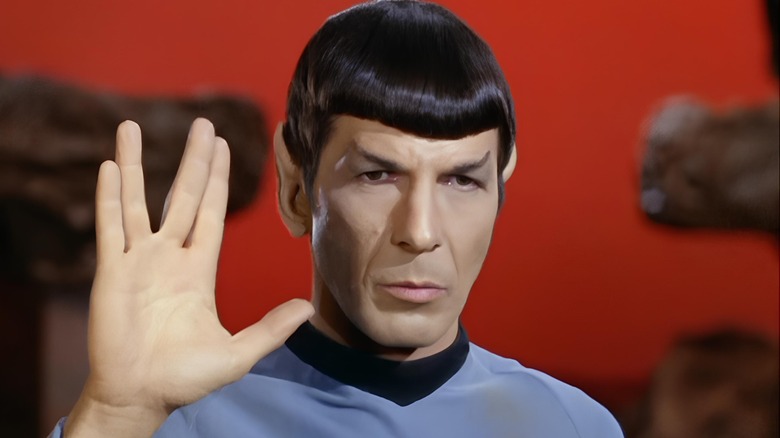
There is no more iconic hand gesture in pop culture than the split-fingered greeting used by Spock (Leonard Nimoy) and other Vulcans in "Star Trek." Usually accompanied by the phrase, "Live long, and prosper," the gesture requires splitting one's fingers between the middle and ring finger while extending the thumb, with the palm facing forward. But while many fans have seen it used throughout "Star Trek," many don't know its name, let alone its origins.
Spock's gesture is known as the Vulcan Salute. It was first seen in the episode "Amok Time," the episode of "Star Trek: The Original Series" in which Spock returns to Vulcan to compete in a mating ritual. Though not originally in the script for that episode, Nimoy felt it would be a good way to add more depth to Vulcan culture. "I suggested to the director that there should be some Vulcan thing that Vulcans do when they greet," Nimoy said in an Archive of American Television interview preserved by FoundationINTERVIEWS on YouTube. It was one of many aspects of Vulcan culture improvised by the actor . But the star clarified that the episode's writer, science fiction author Theodore Sturgeon, had come up with the phrase, "Live long, and prosper."
So, that's what the Vulcan Salute means within the universe of "Star Trek." But for Leonard Nimoy, it had a far more profound personal meaning rooted in his Jewish upbringing.

Leonard Nimoy's Vulcan Salute took inspiration from an ancient Jewish tradition
Leonard Nimoy, who played Spock on "Star Trek: The Original Series" and elsewhere, was raised in a Jewish household in Boston, Massachusetts, as the child of Ukrainian immigrants. His parents were observant, particularly his father, who brought his son along to High Holiday services at their local Orthodox synagogue. There, Nimoy witnessed a ritual that would go on to inform his Vulcan Salute.
Synagogue services on major holidays include the Priestly Blessing. Members of the priestly class of Kohanim — in the most simple terms, those with last names like Cohen and derivations thereof — bless the congregation by lifting their hands with the split-fingered gesture. The difference is that, in performing the Priestly Blessing, both hands are raised.
Crucially, members of the congregation are instructed to avert their gaze while the Blessing is recited, as the priests are said to be channeling the divine presence. Congregants often cover their faces with a tallis, a ritual shawl worn during prayer. But young Nimoy was much too curious to remain under the veil, so he would peer out at the Kohanim from under his father's tallis.
As noted on the Star Trek website, Nimoy wrote, "There were a group of five or six men facing the congregation and chanting in passionate shouts of a Hebrew benediction ... My dad said, 'Don't look.' ... I peeked. And when I saw the split-fingered gesture of these men ... I was entranced. I learned to do it because it seemed so magical. It was probably 25 years later that I introduced that gesture as a Vulcan greeting in 'Star Trek' and it has resonated with fans around the world ever since. It gives me great pleasure since it is, after all, a blessing."
The Canadian Jewish News The CJN
The jewish origins of the vulcan salute.
By Lindsay Traves
“Liv e long and prosper.” These words, along with the Vulcan salute, are immediately recognized and associated with Star Trek , which is celebrating the 53rd anniversary of its first episode this month. Their origins do not emanate from the vast final frontier, however, but rather from Leonard Nimoy’s Jewish heritage.
With Star Trek , Gene Roddenberry’s mission was to tell stories that included elements from a diversity of cultures, be they alien or Earthly. So when Leonard Nimoy had an idea for a Vulcan greeting, Roddenberry let him bring along a piece of his culture.
Nimoy recounted the story of Star Trek ’s Season 2 premiere, titled “Amok Time,” the first episode of the show where Spock visited the planet Vulcan (where he was to be married). It would be the first time another Vulcan would be seen on screen. After considering the greetings people have across cultures, Nimoy thought the Vulcans should have one of their own.
Though most of us immediately recognize the salute as the Vulcan greeting, its true origin comes directly from the Torah.
I met with Rabbi Howard Morrison of Beth Emeth Synagogue in Toronto, an expert on both Judaism and “nerd TV culture,” who told me more about the origin of the salute. “When the Kohanim do the priestly blessing, they take their two hands and bring the thumbs together and it’s like the ‘Live long and prosper’ sign,” he explained. But, Rabbi Morrison continued, the version in the blessing differs slightly: Spock “only does it on the show with the one hand,” he noted, “but the Kohanim , when they do the blessing, use two hands, and connect the thumbs to make the Hebrew letter shin (representing the first letter of one of God’s names).
The hand sign is done during the performance of the blessing by the Kohanim, who stand at the front of the sanctuary and bless the congregation. Historically, this was done daily in the Holy Temple, when it stood in Jerusalem. “You needed the Kohanim and their officiating to be able to fulfill certain Jewish practices,” Rabbi Morrison explained, adding, “Now, the blessing is done ‘symbolically’ by the Kohanim daily in Israel, and outside, during festivals.” (The words in the blessing itself are part of the daily prayers, but the sign we know as the Vulcan salute is only done when the Kohanim are called upon to stand before the congregation and recite them.
READ: SCHWARTZBERG: A TRIBUTE TO HARLAN ELLISON
Though Jewish fans of Star Trek might be thrilled by the revelation of something so deep in our culture, many of us have never seen the hand sign used in religious practice. Per Rabbi Morrison, “You’re not supposed to look when the Kohanim do the blessing and ‘salute,’ because you are supposed to be focusing on the words and thinking of God as opposed to focusing on the people saying the words.
“There are some who believe that if you look, you will go blind, but the idea is that the focus should be on hearing the words and internalizing the meaning of the words and not looking at the Kohanim who are doing it. But neither Nimoy or I could help ourselves – we peeked.” Indeed, the Spock actor recalled a time he attended synagogue and his father told him not to look when five or six men stepped to the bimah and began shouting a blessing. He knew something “major” was happening, so he snuck a view of those men with their hands poking out from their tallitot in a striking hand sign that he thought was “magical.” Years later, Nimoy would suggest this magical hand sign extend from his personal heritage to that of his character.
Though Nimoy could flash the sign with ease, not every Vulcan could. Celia Lovsky, who played T’Pau, the Vulcan minister, was unable to do the sign on her own and had her fingers taped together for production. Zachary Quinto allegedly had some trouble with the salute and did some Vulcan finger exercises while preparing for his most logical role. It was said his fingers were glued together for production, but Quinto swears this is just a rumour. Though I can’t say for sure, I have a suspicion that Arlene Martel, who played Spock’s bride-to-be, T’Pring, a fellow eastern European Jew, could probably flash the sign with ease.
This story was originally published by StarTrek.com and CBS. It has been reprinted with permission.
- The Inventory
Support Quartz
Fund next-gen business journalism with $10 a month
Free Newsletters
The history behind Leonard Nimoy’s Vulcan salute
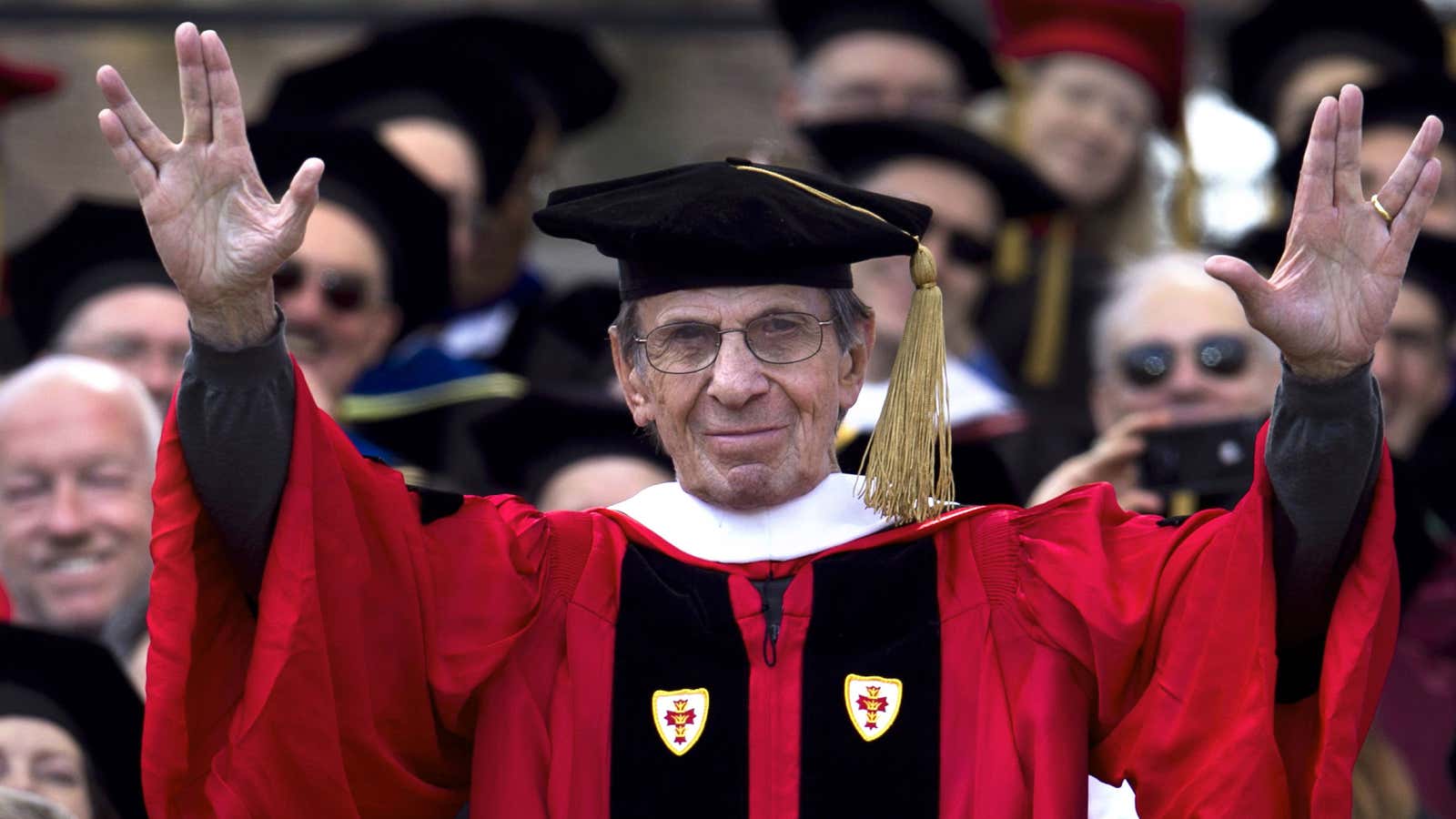
Leonard Nimoy’s passing at the age of 83 is prompting a flood of reminiscences about the actor, artist, and poet best known for his portrayal of the half-human/half-Vulcan Spock on the television series and movies Star Trek .
Many will remember him performing his trademark four-finger Vulcan salute, which the actor actually created himself:
Nimoy drew on his orthodox Jewish upbringing to invent the iconic hand gesture, and he wrote about the process of finding it in his memoir, I am Spock :
For what would soon become known as the Vulcan salute, I borrowed a hand symbol from Orthodox Judaism. During the High Holiday services, the Kohanim (who are the priests) bless those in attendance. As they do, they extend the palms of both hands over the congregation, with thumbs outstretched and the middle and ring fingers parted so that each hand forms two vees. This gesture symbolizes the Hebrew letter shin, the first letter in the word Shaddai, `Lord.’ … So it was that, when I searched my imagination for an appropriate gesture to represent the peace-loving Vulcans, the Kohanim’s symbol of blessing came to mind.
In a chat with the Baltimore Sun in 2000, Nimoy explained how he got the idea:
In the blessing, the Kohanim (a high priest of a Hebrew tribe) makes the gesture with both hands, and it struck me as a very magical and mystical moment. I taught myself how to do it without even knowing what it meant, and later I inserted it into “Star Trek.” There was a scene in one episode that needed something. People were seeing other members of the Vulcan race for the first time, and I thought it called for a special gesture.
📬 Sign up for the Daily Brief
Our free, fast, and fun briefing on the global economy, delivered every weekday morning.
Star Trek: When the Vulcan Salute First Appeared (and What It Means)
Leonard Nimoy created the famous Vulcan salute for Star Trek, but no one could've anticipated just how popular it would become.
Aside from the pointed ears, Mr. Spock's Vulcan salute may be his most iconic feature. The gesture has become synonymous with Star Trek , to the point where fans use it as a standard greeting and subsequent sci-fi efforts like Mork and Mindy satirized it. There are even plans to build a statue honoring the salute in Nimoy’s hometown of Boston. And yet, it was a late addition to the original series , and only came about because Leonard Nimoy had a moment of inspiration.
Nimoy first used the salute in Season 2, Episode 1, “Amok Time,” as a means to express greeting. It was conceived of on the spot during rehearsals, and while Gene Roddenberry subsequently attempted to claim credit for its invention, Nimoy has since recounted its origins in ancient Jewish tradition. He didn’t know that it was going to become a part of Star Trek when he used it, but considering its significance, the connection is quite fitting.
RELATED: Star Trek's Longest Running Series, Revealed
"Amok Time" Defined the Vulcans
“Amok Time” is widely cited as a foundational moment for the cultural development of the Vulcans. Spock is overcome by the effects of pon farr, and must return to his homeworld before it kills him. It was fans’ first opportunity to see Spock’s culture directly, and the character’s popularity turned many of its tropes into accepted Vulcan traits. According to Nimoy, he simply wished to use an appropriately alien hand gesture to greet T’Pau who, as a judge and official over the proceedings, merited proper respect.
The salute had no significance beyond the immediate needs of the scene, but its ease of use meant that Nimoy could repeat it as a kind of shorthand -- along with the trademark “live long and prosper” -- anytime it felt appropriate. Fans began to emulate it for the same reasons, and soon it became an essential part of Star Trek. Adding further intrigue was the fact that some people struggle to make the gesture, with slight mechanical differences in individual hands making it more difficult. In preparing to take on the role of Spock in J.J. Abrams' reboot, Zachary Quinto even confessed difficulty in making the salute, requiring practice for him to perfect it. That odd quirk lent the salute an instant mystique that played into Mr. Spock’s identity perfectly.
RELATED: Star Trek: There's a Good Reason 'The Man Trap' Was the Series' First Episode
The Vulcan Salute Stems from a Jewish Ritual
The gesture itself comes from a blessing in the Jewish faith, made daily to the congregation. The Kohanim priests connect their thumbs and make the sign with both of their hands, which forms the Hebrew letter “shin”, the first letter used in a name for God. Its use as a blessing makes an ideal match for the Vulcans’ benevolence and wisdom and roots their overall spirituality in an actual religious tradition.
The particular circumstances under which Nimoy first saw the symbol bear mentioning as well. According to the actor's account on StarTrek.com , his father told him not to look as the priests conducted the blessing (the congregation should be contemplating God instead of watching the priests.) Nimoy says that he looked anyway, and saw the priests making the sign. It felt magical to him, and he learned how to do it because of his fascination with the gesture. Star Trek inadvertently amplified that fascination and made it a key component in one of the franchises’ most beloved species.
KEEP READING: Picard: Patrick Stewart, John De Lancie Tease Q's Star Trek Return
The Significance And Meaning Of The Star Trek Hand Symbol
- Last updated Jul 26, 2023
- Difficulty Beginner
- Category Symbolism
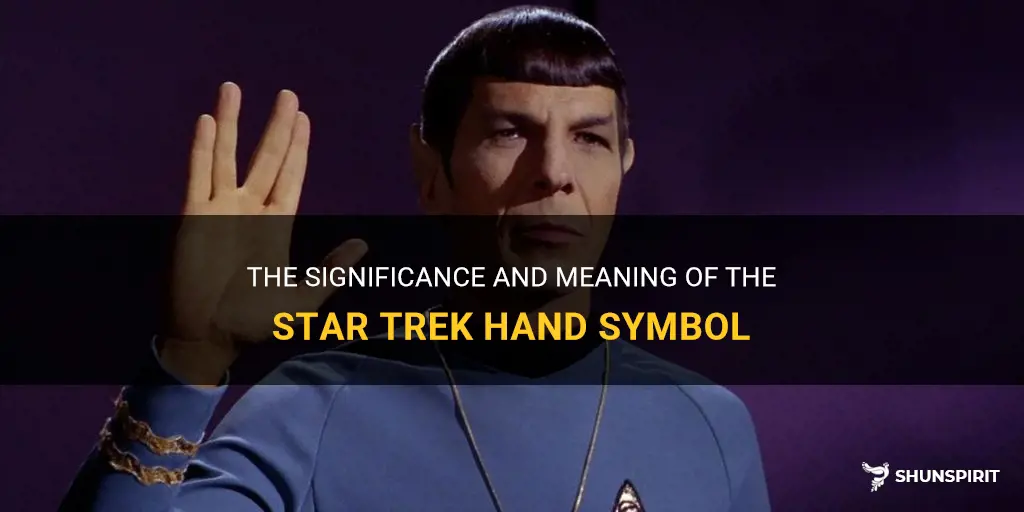
If there is one symbol that instantly transports us to the futuristic universe of Star Trek, it is the famous hand sign. With a simple gesture, the iconic hand symbol became synonymous with the famous greeting live long and prosper and came to represent the ideals of peace, logic, and unity in the Star Trek universe. But where did this symbol originate, and what does it truly mean? Join me on this journey to uncover the mysteries behind the Star Trek hand symbol, as we explore its historical significance and its profound impact on popular culture.
What You'll Learn
What is the origin of the star trek hand symbol, how did the star trek hand symbol become popularized, what does the star trek hand symbol represent in the show, are there any real-life meanings or origins to the star trek hand symbol, how has the star trek hand symbol been embraced by fans and pop culture outside of the show.

The hand symbol commonly seen in the science fiction franchise Star Trek has become widely known and recognized. The gesture, known as the Vulcan salute, is performed by raising the hand and separating the palm from the fingers, leaving only the middle and ring fingers together, while the index and little fingers remain extended. Also known as the "live long and prosper" sign, it has become an iconic symbol associated with the series.
The origin of the Vulcan salute can be traced back to the creator of Star Trek, Gene Roddenberry, and the actor who played the character of Spock, Leonard Nimoy. In the original Star Trek series, Nimoy's character, Spock, was half-human and half-Vulcan, a fictional alien race known for their logic and rationality. Nimoy wanted to incorporate a distinctive greeting for Vulcans that would reflect their unique culture and customs.
The inspiration for the Vulcan salute came from Leonard Nimoy's childhood experiences. He remembered attending a Jewish synagogue service where he observed a gesture performed by the rabbi when giving a blessing. The symbolic gesture involved the hands positioned similarly to the Vulcan salute, with the rabbi's thumb extended and touching his index finger. Nimoy found this ritualistic hand position fascinating and decided to adapt it for Spock's character as a way to emphasize the Vulcan culture's emphasis on logic and intellect.
When Nimoy approached Gene Roddenberry with the idea, the creator of Star Trek liked the concept and immediately incorporated it into the series. From that point forward, the Vulcan salute became an integral part of the Star Trek franchise, often associated with Spock's character and Vulcan culture as a whole.
The popularity of the Vulcan salute quickly spread beyond the boundaries of the show and became a recognizable symbol in popular culture. Fans of the series and non-fans alike started using the gesture as a greeting, a sign of solidarity, or simply as a way to express their love and appreciation for Star Trek.
The phrase "live long and prosper," often associated with the Vulcan salute, also originated from the Star Trek series. It was first used by Spock's character in the episode "Amok Time" and became one of his catchphrases. The phrase encapsulates the core values of the Vulcan civilization, which prioritizes knowledge, reason, and the pursuit of a long and prosperous life.
In conclusion, the Vulcan salute, or the iconic hand symbol from Star Trek, has its origins in Leonard Nimoy's childhood observations of a rabbi's gesture during a Jewish synagogue service. Nimoy adapted this hand position for his character, Spock, to symbolize the Vulcan culture's emphasis on logic and intellect. The Vulcan salute became a recognizable symbol in popular culture and is often associated with the phrase "live long and prosper," which epitomizes the values of the fictional Vulcan society.
What Does the UNK Symbol Mean and How is it Used?
You may want to see also
The Star Trek hand symbol, also known as the Vulcan salute, has become an iconic symbol in pop culture. It is often used as a greeting among Star Trek fans, and has even been adopted by famous personalities and celebrities. But how did this hand symbol become so popularized?
The Vulcan salute was first introduced in the original Star Trek television series, which aired from 1966 to 1969. The salute was developed by Leonard Nimoy, who played the character Spock, a Vulcan science officer on the Starship Enterprise. Nimoy wanted a distinctive greeting for his character, and took inspiration from a Jewish blessing he saw as a child.
The hand symbol itself is made by separating the middle and ring fingers, while the thumb is extended fully and the other fingers are closed. This creates a distinctive "V" shape with the hand. The gesture is accompanied by the phrase "Live long and prosper," which became synonymous with the salute.
When Leonard Nimoy first introduced the Vulcan salute on the show, it was not an instant hit. In fact, many people found it confusing and difficult to replicate. However, over time, the symbol gained popularity among Star Trek fans and became a recognized symbol of the franchise.
The popularity of the Vulcan salute reached new heights with the release of Star Trek movies and spin-off series. The gesture was often used by other characters in the Star Trek universe, further solidifying its association with the franchise.
Outside of the Star Trek fandom, the Vulcan salute gained wider recognition through various forms of media. It has been featured in popular television shows, movies, and even cartoons. The symbol has also been adopted by fans of the show as a way to identify themselves and show their love for Star Trek.
In addition, notable personalities and celebrities have also embraced the Vulcan salute, further contributing to its popularization. People like Barack Obama, Stephen Hawking, and Justin Trudeau have been spotted giving the salute at various events. This has helped to elevate the symbol's status and make it more widely known.
The Vulcan salute's popularity can also be attributed to its unique and distinct appearance. The "V" shape created by the hand symbol is visually striking and easily recognizable. Its association with the Star Trek franchise also adds to its appeal, as the show has a dedicated fan base that spans generations.
Overall, the Vulcan salute's journey from a simple greeting on a television show to a widely recognized symbol in popular culture is a testament to the enduring impact of Star Trek and its dedicated fan base. Its distinctive appearance, association with the franchise, and adoption by notable personalities have all contributed to its continued popularity. The Vulcan salute is now not only a symbol of Star Trek, but also a symbol of unity and connection among fans around the world.
Exploring the Meanings Behind CPT Symbols: Decoding the Secret Language of Medical Coding
In the iconic science fiction franchise Star Trek, one of the most recognizable symbols is the hand gesture often used by the characters. Known as the "Vulcan salute" or the "Live long and prosper" gesture, it has become synonymous with the show and has even entered popular culture.
The Vulcan salute is performed by raising the hand with the palm forward and the thumb extended, while separating the middle and ring fingers to form a "V" shape. The index and little fingers are bent, completing the distinct hand symbol. The gesture was first introduced by the character Mr. Spock, portrayed by Leonard Nimoy, in the original Star Trek series.
The meaning behind the Vulcan salute is rooted in the fictional alien race of Vulcans, who are known for their logic and emotional control. According to the show's mythology, Vulcans greet each other by raising their hand in this manner, accompanied by the phrase "Live long and prosper."
The gesture represents the Vulcan philosophy, which is centered around the pursuit of knowledge, logic, and the suppression of emotions. By using the hand symbol, Vulcans are reminding themselves and others of their commitment to these principles. It serves as a visual reminder of the value placed on reason and intellect, as well as a way to identify and connect with other Vulcans.
Outside of the Star Trek universe, the Vulcan salute has taken on a symbolic meaning of its own. Many fans of the show use the gesture as a sign of their appreciation for the franchise and its values. It has become a way to communicate a sense of unity and belonging within the Star Trek community. The phrase "Live long and prosper" has also been widely adopted as a mantra and a well-wishing expression.
The popularity of the Vulcan salute extends beyond Star Trek itself, with the symbol being recognized by people who may not even be familiar with the show. It has been referenced in other television series, movies, and even political campaigns. This demonstrates the lasting impact of the Star Trek franchise and its ability to create iconic symbols that resonate with audiences.
In conclusion, the Vulcan salute is a hand gesture used by the fictional Vulcan race in the Star Trek series. It symbolizes their commitment to logic and emotional control, as well as a means of identification. The gesture has become a cultural phenomenon, representing unity and appreciation for the franchise. Whether you're a Star Trek fan or not, the Vulcan salute serves as a visual reminder of the show's enduring legacy. So, next time you see the hand symbol, remember to "live long and prosper."
Decoding the Hidden Messages: Understanding Dodge Dashboard Symbols and Their Meanings
The Star Trek hand symbol, commonly known as the Vulcan salute, has become iconic in popular culture. It is recognized worldwide as a symbol of greeting and unity among Star Trek fans. However, it is interesting to explore if there are any real-life meanings or origins behind this gesture.
The Vulcan salute consists of lifting the hand flat and parting the fingers between the middle and ring finger, while the thumb is held against the palm. The gesture was first introduced in the original Star Trek series by Spock, a Vulcan character portrayed by Leonard Nimoy. In the show, it was described as a traditional Vulcan greeting, accompanied by the phrase "Live long and prosper."
The origins of the Vulcan salute, however, can be traced back to Leonard Nimoy's childhood. In his autobiography, "I Am Spock," Nimoy explains that the hand symbol was inspired by a Jewish blessing he witnessed in his synagogue as a child. The blessing, known as the "priestly blessing" or "raising of the hands," is performed by Kohanim (descendants of the Jewish priestly caste) during certain religious ceremonies.
In the blessing, the Kohanim raise their hands with the fingers spread apart, similar to the Vulcan salute. Nimoy was deeply moved by this ritual and its symbolism of unity and connection. He later incorporated it into his portrayal of Spock to add depth and history to the Vulcan culture.
The Vulcan salute quickly became associated with Spock and the Star Trek franchise, and it soon gained popularity beyond the show's fan base. Star Trek conventions, interviews, and public appearances by Leonard Nimoy often included the iconic hand gesture. Over time, the salute came to represent the ideals of peace, logic, and understanding espoused by the Vulcans in the Star Trek universe.
The cultural impact of the Vulcan salute is further exemplified by its adoption and recognition in diverse communities worldwide. The symbol is used as a sign of solidarity among Star Trek fans, often accompanied by the phrase "Live long and prosper." It has also been embraced by various organizations and individuals to promote goodwill and inclusivity.
In conclusion, while the Vulcan salute originated in the fictional universe of Star Trek, its real-life meaning and origins can be traced back to Leonard Nimoy's personal experiences and cultural influences. The hand symbol's connection to the Jewish blessing and its embodiment of unity and connection have contributed to its lasting popularity and significance in popular culture. The Vulcan salute serves as a reminder to embrace diversity, seek understanding, and strive for peace in the real world.
Exploring the Meaning and Importance of Field Weld Symbols
The Star Trek hand symbol, also known as the Vulcan salute, has become an iconic part of popular culture. This hand gesture, made by extending the palm forward with the fingers split between the middle and ring fingers, was first introduced in the original Star Trek series by the character Mr. Spock, played by Leonard Nimoy.
Despite its origins in a science fiction television show, the Vulcan salute has been embraced by fans and has become a symbol of unity and peace. The gesture is often used by fans to identify themselves as part of the Star Trek community, and it has been adopted by various organizations and individuals outside of the show.
One of the most notable instances of the Vulcan salute being embraced by popular culture was during the inauguration of President Barack Obama in 2009. Leonard Nimoy, who created the hand sign, was present at the event and performed the Vulcan salute when he was introduced to the crowd. This moment not only highlighted the cultural significance of Star Trek but also showed how the hand symbol has transcended its fictional origins to become a symbol of hope and unity.
The Vulcan salute has also been used in various forms of media and entertainment. It has made appearances in other television shows and movies, such as The Big Bang Theory, where the character Sheldon Cooper often uses the salute as a reference to his love for Star Trek. Additionally, the hand symbol has been featured in advertisements, artwork, and fan creations, showcasing its widespread popularity.
Outside of media and entertainment, the Vulcan salute has been embraced by various organizations and individuals as a symbol of peace and unity. It has been used in protests and demonstrations as a way to express solidarity and promote inclusivity. It has also been incorporated into various logos and designs, representing values such as diversity and acceptance.
The influence of the Vulcan salute can even be seen in scientific and technological advancements. For example, NASA astronauts Mark Lee and Jan Davis famously performed the Vulcan salute in space during the STS-47 mission in 1992. This gesture not only showcased their love for Star Trek but also highlighted the connection between science fiction and scientific exploration.
In conclusion, the Star Trek hand symbol, or Vulcan salute, has been embraced by fans and popular culture outside of the show. It has become a symbol of unity, peace, and hope, and has been adopted by various organizations and individuals. Through its appearances in media, entertainment, and even space exploration, the Vulcan salute continues to exemplify the influential impact of Star Trek on society.
Deciphering the Meaning Behind Satanic Symbols: Unveiling the Veil of Darkness
Frequently asked questions.
The Star Trek hand symbol is known as the Vulcan salute, which is a hand gesture used by the fictional Vulcans in the Star Trek universe. It consists of raising the hand, separating the fingers between the middle and ring finger, and keeping the thumb extended. The gesture is often accompanied by the phrase "live long and prosper."
The Star Trek hand symbol is not a real sign language gesture, but it was inspired by a Jewish blessing. Leonard Nimoy, the actor who played Mr. Spock, based the Vulcan salute on the traditional priestly blessing performed by Jewish Kohanim during religious ceremonies. Nimoy wanted to create a unique gesture for his character that conveyed a sense of peace and spirituality.
The Star Trek hand symbol gained popularity through the Star Trek television series and subsequent movies. As the character of Mr. Spock became increasingly popular, so did his iconic gesture. Fans of the show began adopting the Vulcan salute as a way to express their love for the series and to identify themselves as Star Trek enthusiasts. The hand symbol has since become a widely recognized symbol of Star Trek fandom.

- Seti Author Editor Reviewer

- Aarti Deegwal Author Editor Reviewer
It is awesome. Thank you for your feedback!
We are sorry. Plesae let us know what went wrong?
We will update our content. Thank you for your feedback!
Leave a comment
Symbolism photos, related posts.

Decoding the Hidden Meanings Behind Cross Symbols
- Jul 27, 2023
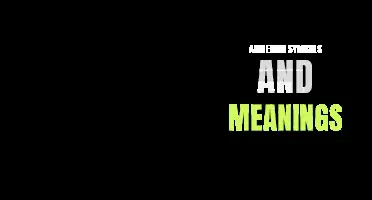
Exploring the Rich Symbolism and Hidden Meanings of Armenian Culture
- Jul 19, 2023
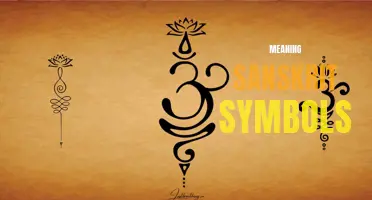
The Symbolic Meanings of Sanskrit Symbols: Unlocking the Ancient Wisdom
- Jul 20, 2023

Understanding Electronic Symbols and Their Meanings
- Jul 26, 2023
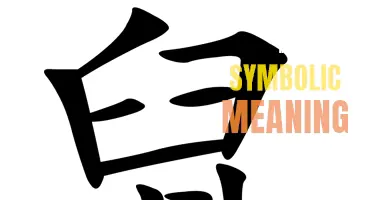
Exploring the Symbolic Meaning of Rats: What Do They Represent?
- Jul 22, 2023

Unraveling the Mysteries: Exploring the Symbols and Meanings of Love
- Jul 24, 2023
- My Reading List
- Account Settings
- Newsletters & alerts
- Gift subscriptions
- Accessibility for screenreader
The Jewish roots of Leonard Nimoy and ‘live long and prosper’
Leonard Nimoy first saw what became the famous Vulcan salute, “live long and prosper,” as a child, long before “Star Trek” even existed. The placement of the hands comes from a childhood memory, of an Orthodox Jewish synagogue service in Boston.
The man who would play Spock saw the gesture as part of a blessing, and it never left him. “Something really got hold of me,” Nimoy said in a 2013 interview with the National Yiddish Book Center.
Nimoy, who died on Friday , spoke about the Jewish roots of the famous gesture for an oral history project documenting the lives of Yiddish speakers, of which Nimoy is one.
[ Leonard Nimoy’s final public words: ‘Live long and prosper’ ]
At the beginning of the interview, Nimoy talked about his childhood in Yiddish. He was born in Boston, but his parents came from a village in what is now Ukraine, where his father worked as a barber. “My first language was English,” Nimoy told the interviewer in Yiddish, “but I needed to speak Yiddish with my grandparents.”
A disclosure: Years ago, as a college student, I worked part-time at the National Yiddish Book Center, which is located on my alma mater’s campus.
Although Nimoy never hid his upbringing from the world, my short experience there is why Nimoy’s work to preserve the language of his childhood came to mind today. I reached out to the Center, which explained that Nimoy started recording Jewish short stories, from Eastern Europe, in 1995, for a radio show hosted by the Center. He funded another project to record Yiddish stories and distribute them to children.
“Toward the end of his life, he called for increased efforts to teach Yiddish to a new generation,” Aaron Lansky, the center’s president, added in an email. “I’m not sure any Vulcan ever spoke a more geshmak (flavorful) Yiddish. He will be missed.”
[ Leonard Nimoy’s struggle with being Spock ]
Nimoy’s incorporation of the blessing speaks particularly poignantly about the permeable boundaries between Spock and Nimoy himself.
“This is the shape of the letter shin,” Nimoy said in the 2013 interview, making the famous “V” gesture. The Hebrew letter shin, he noted, is the first letter in several Hebrew words, including Shaddai (a name for God), Shalom (the word for hello, goodbye and peace) and Shekhinah, which he defined as “ the feminine aspect of God who supposedly was created to live among humans.”
The Shekhinah, Nimoy has said , was also the name of the prayer he participated in as a boy that inspired the salute. The prayer, meant to bless the congregation, is named after the feminine aspect of God, Nimoy explained in a 2012 post on the “Star Trek” site. “The light from this Deity could be very damaging. So we are told to protect ourselves by closing our eyes,” he wrote in the blog.
“They get their tallits over their heads, and they start this chanting,” Nimoy says in the 2013 interview, “And my father said to me, ‘don’t look’.” At first he obliged, but what he could hear intrigued him. “I thought, ‘something major is happening here.’ So I peeked. . And I saw them with their hands stuck out from beneath the tallit like this,” Nimoy said, showing the “V” with both his hands. “I had no idea what was going on, but the sound of it and the look of it was magical.”
After witnessing the ritual all those years ago, Nimoy practiced making the “V” with his fingers as a child. He “never dreamed” he would one day make the gesture so publicly and repeatedly as an adult.
That was, he said, until a “Star Trek” script required his character Spock to go home to Vulcan. “It was the first time we’d seen other Vulcans, other people of my race, so I was hoping to find some touching that could help develop the Vulcan sociology,” Nimoy said.
“I think we should have some special greeting that Vulcans do,” Nimoy recalled saying. He suggested the prayer gesture from his childhood.
“Boy,” he said, “that just took off. It just touched a magic chord.
He noted that “most people to this day still don’t know” the history of the greeting, although he repeatedly and enthusiastically shared its origin.
Laughing, Nimoy revealed the best part of it all: “People don’t realize they’re blessing each other with this!”
Michelle Boorstein contributed reporting.
[This post has been updated]
We are a participant in the Amazon Services LLC Associates Program, an affiliate advertising program designed to provide a means for us to earn fees by linking to Amazon.com and affiliated sites.
We noticed you’re blocking ads!
new video loaded: Nimoy Explains Origin of Vulcan Greeting
Nimoy Explains Origin of Vulcan Greeting
As part of the yiddish book center wexler oral history project, leonard nimoy explains the origin of the vulcan hand signal used by spock, his character in the “star trek” series., remembering leonard nimoy.
Advertisement
NOW PLAYING
The Man Who Was Spock
- More to Explore
- Series & Movies
Published Aug 23, 2023
The Starfleet Insignia Explained
No Star Trek symbol captures the eye or imagination quite like the delta.

StarTrek.com
"The Starfleet Symbol." "The Arrowhead." "The Delta."
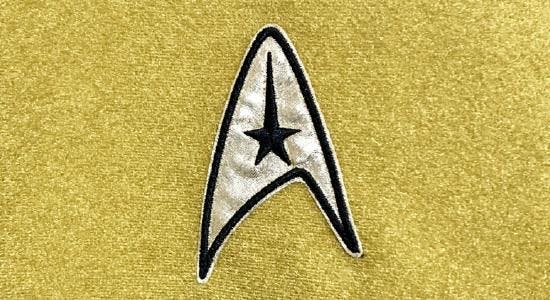
Star Trek uses symbols to convey a lot of things, but none captures the eye or imagination quite like the delta. In the years since The Original Series first aired, fans have tried to determine the meaning behind the various insignia shapes we see in the show. To most, it seems that the iconic delta shape is some sort of ship assignment patch meant to represent the U.S.S. Enterprise .
Some arrive at this conclusion because they see various Starfleet personnel wearing a number of different insignia. However, like any puzzle without a key, it’s impossible to precisely interpret the meaning of these other insignia.
The hidden key to the puzzle was finally uncovered a few years ago. The discovery was a memorandum written by producer Robert H. (Bob) Justman to costume designer William Ware (Bill) Theiss . The subject? STARSHIP EMBLEMS.
A copy of that memorandum has been digitized from the Gene Roddenberry Star Trek Television Series Collection (held in the Library Special Collections division of the Young Research Library at UCLA in Irvine, California) and is shown below:
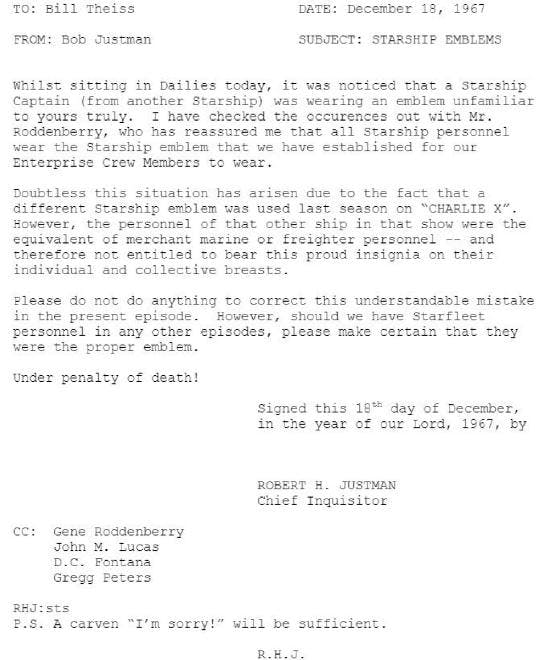
This memo, written during the production of the episode "The Omega Glory," and referencing Captain Ron Tracey, nullifies the long-held assumption that Starfleet assigned different insignia shapes to starships during TOS. Theiss’ inclusion of an alternate insignia for the Exeter 's captain and chief medical officer, unfortunately, downplays how genuinely ubiquitous the delta insignia is within the Star Trek universe. As a result, fans of the series are left with conflicting visual information regarding the meaning of the insignia worn throughout the original series.
Nearly 50 years after Bob Justman wrote his memo, we now have the opportunity to clarify the use of each and every Starfleet uniform insignia used in TOS. With a wee bit of Scotty's ingenuity, and a pinch of Vulcan logic, the complete picture of what Gene Roddenberry envisioned for the delta insignia should snap into focus.
There are six Starfleet duty insignia used in The Original Series:
- Starship Duty Insignia (Fleet personnel emblem)
- Spacecraft Duty Insignia (Auxiliary Fleet/ Merchant Marine personnel emblem)
- Outpost Duty Insignia (Outpost and Colony personnel emblem)
- Cadet Duty Insignia (Starfleet Academy student emblem)
- Starbase Duty Insignia (Headquarters, Space stations, Drydocks, and Ground installation personnel emblem)
- Fleet Command Insignia (Senior field commander personnel emblem)
In the Star Trek universe, the delta emblem is a direct descendant of the vector component of the old NASA (and later UESPA) logos in use during Earth’s space programs of the 20th and 21st Centuries. Those symbols were worn by some of the first space explorers and adorned uniforms and ships during humanity’s first steps into the final frontier.
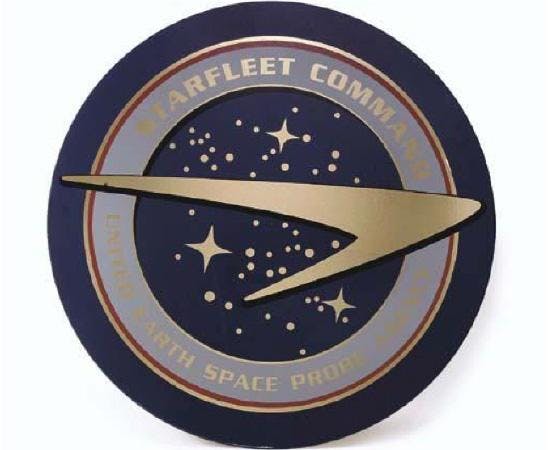
United Earth Space Probe Agency integrated with Starfleet as the leading United Earth space exploration service.
The delta insignia was first drawn in 1964 by costume designer William Ware Theiss with input from series creator Gene Roddenberry. The delta — or “Arrowhead” as Bill Theiss called it — has evolved into a revered symbol and one that's synonymous with Star Trek today.
The delta also conveys information about the wearer’s duties aboard ship using a series of division symbols. When paired with a distinctive, elongated “star,” the insignia represents someone assigned to the Command division aboard ship. When it displays the “planet” symbol, it represents the Sciences division, a stylized “e” stands for Engineering (later Operations), and a red “Swiss Cross” is worn by starship personnel assigned to the Nursing Corps.
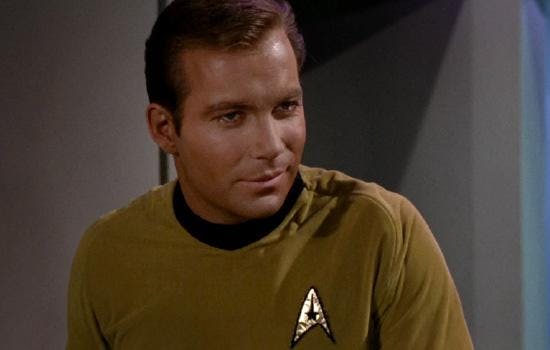
Captain James T. Kirk wearing the Starship Duty Insignia, Command Division.
Let’s continue our study of Star Trek ’s insignia with personnel assigned to other starships that are wearing the delta insignia.
Before we knew about this memo, we assumed that each ship had its own unique insignia, but there are problems that theory doesn't account for. For instance, does it bother you, or at least seem odd to see the surly guys in Starbase 11’s Officer's Club (in the episode "Court Martial") giving “their captain” a hard time over the presumed death of their mutual friend Ben Finney? Or, to see deceased crew members aboard the U.S.S. Defiant (in the episode "The Tholian Web") wearing the delta insignia?
If different starships had different symbols, why weren't they wearing them? Simple. The memo makes it clear that those Starfleet officers are not assigned to the Enterprise ; they are simply wearing Starfleet’s standard-issue Starship Duty Insignia.

Non-Enterprise Starfleet personnel in Starbase 11’s Officer’s Club in Court Martial, and Below: Deceased U.S.S. Defiant crew member wearing the Starship Duty Insignia in "The Tholian Web."
By now, you might be saying, “What about U.S.S. Exeter ’s Captain Ron Tracey and his chief surgeon, Dr. Carter?” As these two insignia patches are the error being addressed in the memo, they need no further explanation. They alone are the anomaly (an anomaly Theiss never repeated), which led to the misconception that every ship has its own assignment insignia.

Above: Captain Ron Tracey of the U.S.S. Exeter, and Below: his CMO, Dr. Carter.
As you can see here, Theiss thoughtfully, if erroneously, provided both officers with unique assignment insignia patches, and in keeping with his fastidious reputation, insured both patches included their appropriate division symbols.
Early in TOS, we get our first look at non-delta insignia. In the episode "Charlie X," Antares ’ Captain Rampart and his first officer are wearing the Spacecraft Duty Insignia, which indicates that they are assigned to an auxiliary spacecraft serving in Starfleet's Merchant Marine Corps — just as Justman points out in his memo.
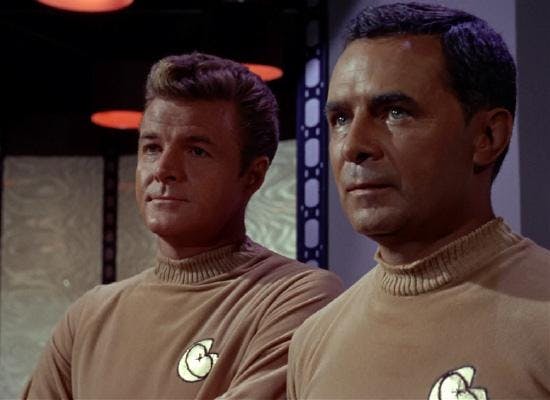
Antares' Captain Rampart, and his XO wearing the Merchant Marine Spacecraft Duty Insignia.
Not long after that, we get a look at another new insignia. The Outpost Duty Insignia is worn by Starfleet personnel assigned to outposts on the very edge of Federation space, the frontier. This emblem is characterized by a gold spikelet against a black background. Warning: Do not put yourself in a situation where this insignia goes on your uniform. Personnel wearing this badge never seem to live happily ever after.

Outpost Crew from "Balance of Terror" & "Arena" pictured wearing the Outpost Duty Insignia.
A few episodes later, the Enterprise takes shore leave and Kirk reminisces about his days at the Academy. Worn by students attending Starfleet Academy, the Cadet Duty Insignia is characterized by a pewter colored, smaller version of the Starbase Duty Insignia.
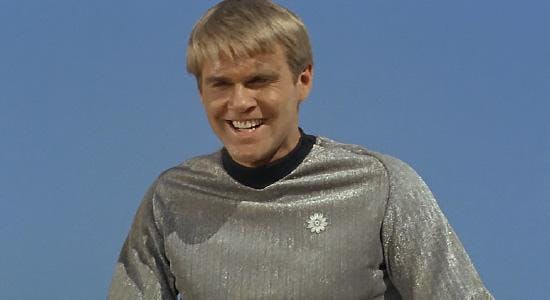
Second Class Midshipman Finnegan wearing the Cadet Duty Insignia.
First seen in "The Menagerie," the Starbase Duty Insignia is worn by personnel assigned to Federation Starbases, which include Starfleet Headquarters, space stations, drydocks, and other ground installations. The emblem, which is devoid of any departmental symbol, is a stylized representation of an “Evening Starflower” (a flowering plant native to the western hemisphere of Earth).
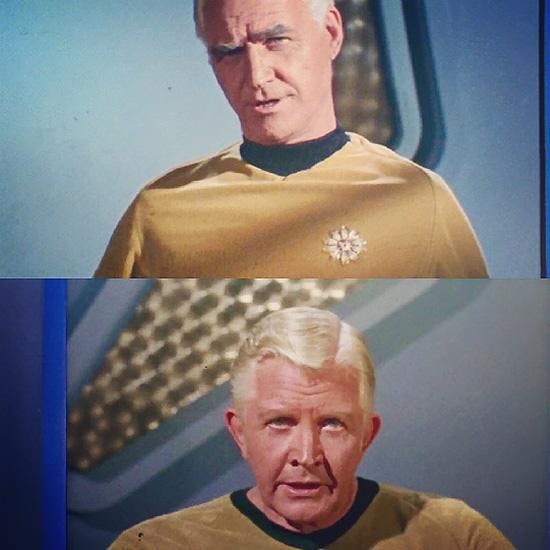
Above: Admiral James Komack of Starfleet Command - Sector 9, and Below: Admiral Fitzpatrick.
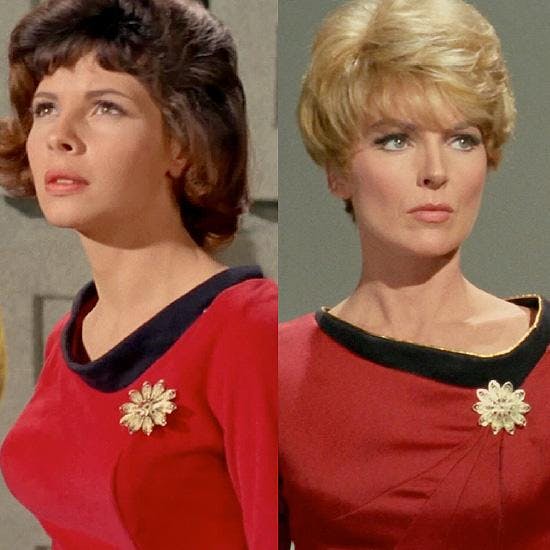
Miss Piper, assistant to Commodore Mendez, and Lt. Areel Shaw Starbase 11 JAG Officer wearing the Starbase Duty Insignia.
So how does Commodore Wesley in "The Ultimate Computer," or Commodore Decker in "The Doomsday Machine," fit into the spectrum of Starfleet insignia?
Well, let’s talk about commodores for a moment. A commodore is a flag officer rank, one position above captain. A starship captain usually commands a single vessel, but a commodore ordinarily commands more than one ship. Usually, commodores command a group of ships (either close to their flagship or distant), or in the case of TOS, they normally command a starbase.
In charge of evaluating the operational performance of the M5 computer while it's in total control of a starship, Commodore Wesley sits in temporary command of the U.S.S. Lexington to lead a battle fleet in war games against the Enterprise . Throughout the episode, Commodore Wesley continues to wear his Starbase Duty Insignia, while the Lexington crew would have been wearing the delta.
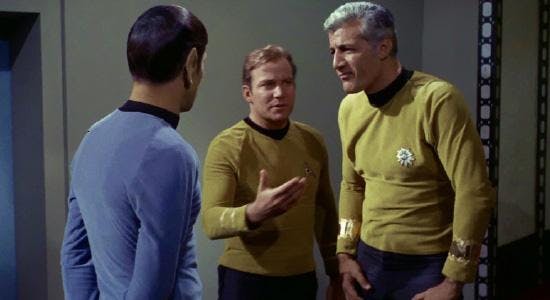
Commodore Bob Wesley in the transporter room briefing Captain Kirk and Mr. Spock about the M5 computer.
Finally, we come to one of my favorite characters ever — Commodore Matt Decker in "The Doomsday Machine." We saved him for last because we could only properly discuss his insignia and what it means after we talked about Starfleet’s other symbols first.
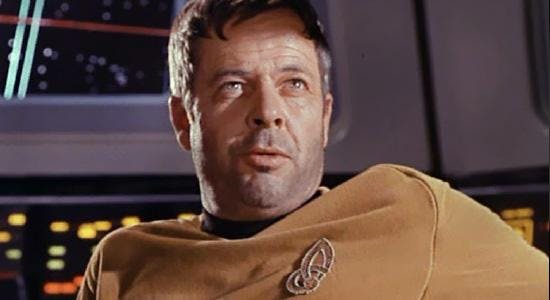
William Windom as Commodore Matt Decker
Unlike Commodore Bob Wesley, who was only in temporary command of the Lexington , Matt Decker is a Flag Officer with permanent field command of a starship. In fact, he's the only Flag Officer we see in Star Trek with a field command. As a consequence of Commodore Decker's rank and status as Commander of the U.S.S. Constellation (his flagship), he wears the Fleet Command Insignia denoting his status as a Flag Officer in the field. If we had seen Commodore Decker's crew (may they rest in peace), we would have seen the delta shape insignia in use on their uniforms. Commodore Decker's own first officer would have held the rank of Captain and worn the Starship Duty Insignia.
It should be noted that "The Doomsday Machine," which was filmed early in Season 2, is not referenced in Bob Justman’s memo. Some speculate that Decker’s absence from the memo is further indication of the inconsistent use of emblems in Star Trek , but that presupposes that the production staff missed that detail. However, the very existence of the Justman memo, and a whole forest of others just like it, demonstrates that the opposite is true.
The production team of Star Trek worked diligently to ensure that every aspect of the future they were busy creating held up under scrutiny. Gene Roddenberry was notoriously rewriting scripts himself to ensure no less than exactly what he wanted ended up on-screen, and that fastidious nature permeated the entire production staff. That Decker’s unique emblem is not mentioned in the production memo indicates that his particular insignia isn't an error at all; but represents something else.
Check out Commodore Decker's insignia. Remember that when Theiss created the insignia for Captain Ron Tracey, he went out of his way to ensure it was emblazoned with a Command Star department symbol. Commodore Decker has no such departmental symbol in his insignia patch, which places it in the same design lineage as the Starbase Duty Insignia, which is also devoid of any departmental symbol.
At this point in Star Trek , we’ve seen a number of flag officers; but they have all worn the Starflower shape, which indicates assignment to a starbase, while Matt Decker alone in TOS series serves as a flag officer in permanent command of a starship. He is wearing an insignia that conveys his unique status, the Fleet Command Insignia, and if you look closely, you'll see that Matt Decker’s emblem is visually related to the Starbase Duty Insignia. Decker’s insignia is a stylized representation of an individual petal from the same “Evening Starflower” emblem that comprises the starbase symbol. This insignia isn't mentioned in the production memo because it's not an error at all.
Hopefully, by now, you can see how consistent the Star Trek costume department really was in their use of insignia, and that Bill Thiess never repeated the error he made during "The Omega Glory" after it was pointed out by the memo.
Returning to the delta, Roddenberry and Justman intended it to be a very special symbol that communicates something important. The insignia worn on Starfleet uniforms is the equivalent of the badges worn by U.S. Service members — to show how they serve, not where they serve. Both men served with distinction in World War II. Roddenberry was an Army Air Corps pilot and Justman was a radio operator in the Navy. In the air and at sea, they understood the value of visual communication. In uniform, they themselves carried those values on their chests, on their collars, and on their sleeves. Twenty years after they wore their own various insignia, they helped to create something new — a symbol to inspire others. In the 1960s, the Starfleet delta had far more in common with the golden pin awarded to a NASA astronaut than a simple mission patch, and it was intended to equal that proud emblem in both use and sentiment.
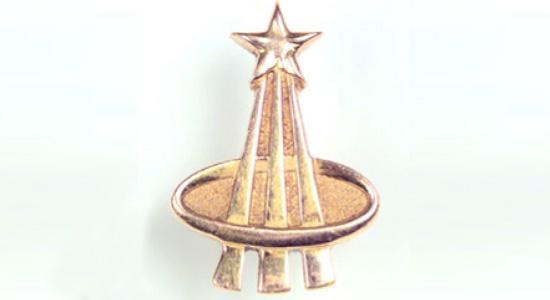
The NASA Astronaut Pin. There are two versions of this pin, a silver pin awarded to those who complete their training, and a gold pin awarded only to astronauts who have flown in space.
The delta proclaims that the person wearing it has achieved the goal of every cadet entering the Academy, and the dream of many a devoted fan — to serve aboard a starship and set sail in an endless sea of stars.
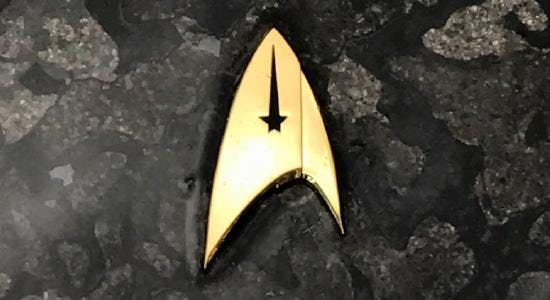
Starfleet Insignia Badge, Command Division from Star Trek Discovery
They used to say if man could fly, he'd have wings. But he did fly. He discovered he had to.
Captain James T. Kirk
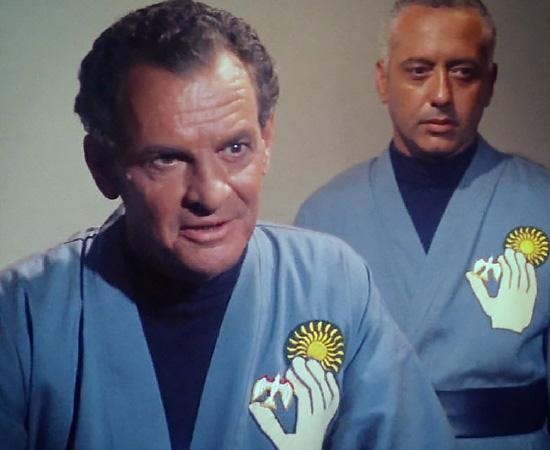
I am grateful to have an experienced and learned group of expert Star Trek fans who helped with the research on this article — Steve Fronczek, Creative Services Manager, ANOVOS; Lieutenant Commander Michael J. Quigley, United States Navy; and Dayton Ward, Star Trek author.
Get Updates By Email
This article was originally published on October 7, 2018
John Cooley is a lifelong Star Trek fan.
- Behind The Scenes
- Star Trek 101

Give Me a Sign: The Stories Behind 5 Hand Gestures
By rob lammle | jan 19, 2023, 10:28 am est.

So much can be said with a hand gesture. Here are the stories behind gestures you might use every day, and some you might not.
Table Of Contents
1. the vulcan salute, 2. the shaka sign, 3. the corna, 4. the pledge of allegiance, 5. the high five.
We all know it, even if we can't all do it. The Vulcan Salute, made famous by Leonard Nimoy as Mr. Spock on the original Star Trek , has become a cultural icon recognized even by those who have never been to a sci-fi convention. And while the gesture is meant to be from another planet, its inspiration is anything but alien.
When Nimoy was a child, he witnessed a Jewish ritual called the "kohane blessing," which uses a hand sign meant to resemble the Hebrew letter "shin," which symbolizes the Hebrew word for "Shaddai," meaning "Almighty (God)." (Got that?) It's made by splitting the hand down the middle—holding the index and middle fingers together, the ring and pinky fingers together—and then the thumb pressed firmly against the side of the hand. The Orthodox priest giving the blessing holds both hands out in front of him in these strange configurations, palms down. When Nimoy was developing a greeting to be used between Vulcans, he remembered the sign and adapted it, using only one hand held up, and pulling his thumb away from the rest of the hand.
Nimoy had no problem doing the salute, but not all Trek actors have been so lucky.
William Shatner had to have his fingers tied together with fishing line whenever Captain Kirk needed to use the sign. Even the latest pointy-eared Vulcan, actor Zachary Quinto, who played a younger Mr. Spock in the recent blockbuster film, had to have his fingers stuck together with the skin-safe superglue used by hospitals as a replacement for traditional stitches.
The oldest origin story goes back to the days when Spanish sailors first landed on the Hawaiian Islands. Unable to speak the native tongue, but trying to be friendly, the Spaniards offered to share a drink by mimicking a bottle with their hand with the gesture and tilting back their head. This became such a common greeting that the natives simply believed that's how the Spanish said hello, so they started using the sign whenever the two groups encountered one another.
Another theory, from the mid-20th Century, claims the sign was inspired by the wave of a beloved local named Hamana Kalili, who'd lost the middle fingers on one hand. There are multiple theories as to how he lost his fingers: there was a shark attack, they were blown off while using dynamite to catch fish, or perhaps the digits were lost in an accident while working on a sugar plantation. But no one knows for sure anymore.
As if the origin of the gesture isn't mysterious enough, the word Shaka isn't even Hawaiian. However, most people agree the name goes back to a local used car salesman, Lippy Espinda, who would throw up the sign at the end of popular TV commercials during the 1960s and 70s, and say, "Shacka, brah!" ("Shocker, bro!")
During his Inauguration Parade, Barack Obama threw the Shaka Sign to greet Honolulu's Punahou School marching band.
If you're in Italy or Spain and you flash this sign towards a man, you might get beaten up. In this culture, the symbol represents the horns of one of nature's most virile animals, the bull. The bull in this case is usually meant to symbolize the guy sleeping with the man's wife behind his back. The sign can also be interpreted with the cuckold as the bull, who has been symbolically castrated by his wife. Either way it's bound to make him see red.
However, turn your palm down and point the extended fingers at someone who doesn't like you, and you're simply guarding yourself from the Evil Eye. In ancient times, bulls were often seen as protective deities, so turning the bull's horns against an enemy was a way of keeping the curse at bay.
On a similar note, in South America, if you have the horn sign held up and twist it back and forth, it's known as "lagarto" or Lizard Gesture. Similar to the old superstition "Knock on wood," it's thought that by doing this you can protect yourself from any bad mojo that might occur after someone utters the taboo word "culebra," or snake.
Of course the corna is also used by fans of the University of Texas, where they call it the "Hook 'Em Horns." Created in 1955 by student Harley Clark, the sign represents the school's mascot, a Texas longhorn steer named Bevo, and his impressive 72" horns. Being a
Texas native
former Governor of Texas, though not a UT alumni, President George W. Bush and his family were known for flashing the Hook 'Em Horns during appearances in the Lone Star State.
But there's another group of fans who use the corna, too "“ fans of heavy metal music. The gesture in metal goes back to occultist band Coven, a group heavily inspired by counter culture figures like renowned Satanist Anton LaVey, who used the corna as a sign of the Devil. However, it was Ronnie James Dio, lead singer for Black Sabbath in the late-1970s, that really made the sign take hold in the genre. He borrowed the gesture from his superstitious Italian grandmother who used it to ward off evil. He felt the sign's pagan origins fit perfectly with the subject matter of the band's music.
Chances are, when you were saying the Pledge of Allegiance in elementary school, you placed your hand over your heart in a sign of adoration for Old Glory. But if you were in school before World War II, you probably used an entirely different gesture to address the flag—the Bellamy Salute.
However, as the years went by, parts of the Bellamy Salute fell out of use, while others evolved. First, the military salute was abandoned, leaving only the straight arm presentation of the flag. But then the palm went from facing up, to sideways, and by the 1940s, it faced down. This last version became a problem as America entered World War II, because it so closely resembled the stiff-armed salute of dictators Mussolini and Hitler. The hand over the heart gesture was suggested as a viable alternative and President Franklin Roosevelt signed it into law in 1942 as part of the Flag Code, making it the official gesture for the Pledge of Allegiance we all know today.
While no one can say for sure where the high five came from, some believe the first one was exchanged between Glenn Burke and Dusty Baker, baseball players for the L.A. Dodgers, after a home run in 1977. But there is one man who claims he knows the origin of the high five, because he says he's the guy who invented it.
Lamont Sleets, Jr. says he adopted the high five from a salute his father exchanged with old Army buddies from the 5th Infantry regiment, nicknamed "The Five." To say hello, the men would stick their hand straight up in the air, spread their fingers wide, and call out "Five!" Anytime he saw the Five greeting, Sleets Jr. would say "Hi, Five!" to the visiting veteran and slapped the upraised hand with his own. Sleets Jr. went on to become one of the top basketball players at Murray State University in the late-1970s and he brought his odd salutation with him. It became popular with his teammates, and as the team traveled the country to play other schools, Sleets says the gesture caught on.
To celebrate this infamous hand gesture, students at the University of Virginia created "National High Five Day," which takes place on the third Thursday in April (yesterday). * * * * * * Have a favorite fun hand gesture we didn't mention? Is there one you've always wondered where it came from? Tell us about it in the comments below!
Emoji dictionary
🖖 vulcan salute emoji.
[ vuhl -k uh n s uh - loot ih- moh -jee ]
What does 🖖 Vulcan Salute emoji mean?
Live long and prosper, friends! If you ever need to spread the love to your geekier friends, then flash a 🖖.
The Vulcan salute emoji, 🖖, is perfect for showing your Star Trek cred or sci-fi pride more generally.
Related words
Where does 🖖 vulcan salute emoji come from.
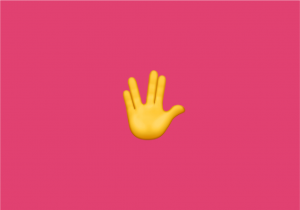
The Vulcan Salute emoji is officially called the raised hand with part between middle and ring fingers emoji. And, that’s exactly what the emoji shows across platforms. Its default hue is yellow, but skin-tone modifiers allow users to change color. It joined emoji keyboards under Unicode 7.0 in 2014.
The emoji commonly goes by the Vulcan salute because the gesture was popularized by Mr. Spock (Leonard Nimoy), who used it as a greeting in the sci-fi franchise, Star Trek . Nimoy first used the gesture in the 1967 TV episode “Amok Time,” in which Spock comes into contact with other members of his Vulcan race.
Nimoy wanted the Vulcans to have a way of greeting one another similar to human hand gestures. In an interview with New York Times , Nimoy said that his Vulcan salute was inspired by a gesture that he witnessed during a Jewish religious service when he was a boy. Jewish priests perform the actual religious gesture with both hands to form the Hebrew letter shin , ש.
The greeting Live long and prosper! has also accompanied the Vulcan salute ever since its debut in “Amok Time,” also inspired by Jewish scripture, with Deuteronomy 5:33 being the most cited inspiration for the phrase.
The Vulcan salute went memetic almost immediately after Nimoy’s first usage of the gesture. According to Nimoy, mere weeks after “Amok Time” aired, people were already using the gesture to greet him everywhere he went. The gesture was first popular among Star Trek fans but the gesture’s similarity to the popular V-shaped peace hand gesture (✌️), both in finger placement and good-willed intent, helped it catch on outside that community.
The Vulcan salute was popular long before the rise of social media, so it comes as no surprise that the emoji version took off right away after Unicode added it on June 16, 2014.
🖖 — Kim Ahlström (@Kimtaro) June 16, 2014
Prior to that day, users had to make due with typographical substitutes.
@pruet \V/_ Vulcan salute — Keng ☂ (@kengggg) November 14, 2007
Examples of 🖖 Vulcan Salute emoji
Who uses 🖖 vulcan salute emoji.
The Vulcan salute emoji is used anytime someone wants to flash the greeting and good wishes. It can be Star Trek fans …
Happy Birthday to our Trekkie Girl Carole! Have a trektastic day! 🖖 🍸🍾 — Trekkie Girls (@TrekkieGirls) October 17, 2016
Live long & prosper. Trekkie and proud 🖖 pic.twitter.com/omklaAa5ak — Lola Dreambomb (@Lola_Dreambomb) July 22, 2016
… or your non-Trekkie but self- avowed nerd friends. In this vein, the emoji can suggest anything “geeky” or “far out.”
Happy birthday nerd. May you live long and prosper 🖖 in Jesus name. God bless you homie @J_Anowa — Bruce Wayne💰💵 (@Bizzle025) July 16, 2018
embrace the martian 🖖 — Genius (@Genius) July 17, 2018
The Vulcan salute emoji is also commonly used when tweeting about (or to) actors that appeared in Star Trek.
Happy 78th Birthday to Patrick Stewart …🖖 pic.twitter.com/bgA4gsL0Bg — Phil Murphy (@crashtesterX) July 13, 2018
George Takei knows the score. 🖖 https://t.co/qInzV1IRsH — Ross Colquhoun (@rosscolquhoun) June 24, 2016
William Shatner is in Lowell today 🖖 — V. Arun (@A_Venugopal_97) June 11, 2015
While the Vulcan salute emoji is widely used when discussing anything Star Trek related, such as old episodes or new films, it can also mark content dealing with science fiction works in general.
🤔 Like anyone could possibly just rank their favorite all-time episode @StarTrek ?!? Ridiculous! #TrekRanks 🖖📊 https://t.co/KYzfPRXacD — TrekRanks Podcast 🖖📊 (@TrekRanks) July 24, 2018
For all who love Sci-Fi movies that really fuck with your head and concept of reality/time, watch 'Arrival' .. great movie, still confused as tits 10/10 wont sleep tn 👍🖖 — MariJane (@mariman777) July 25, 2018
This is not meant to be a formal definition of 🖖 Vulcan Salute emoji like most terms we define on Dictionary.com, but is rather an informal word summary that hopefully touches upon the key aspects of the meaning and usage of 🖖 Vulcan Salute emoji that will help our users expand their word mastery.
- By clicking "Sign Up", you are accepting Dictionary.com Terms & Conditions and Privacy policies.
- Name This field is for validation purposes and should be left unchanged.
Other categories
- Famous People
- Fictional Characters
- Gender & Sexuality
- Historical & Current Events
- Pop Culture
- Tech & Science
- Translations
Star Trek Changed My Life Forever And Reigns As The Greatest Sci-Fi Franchise Of All Time
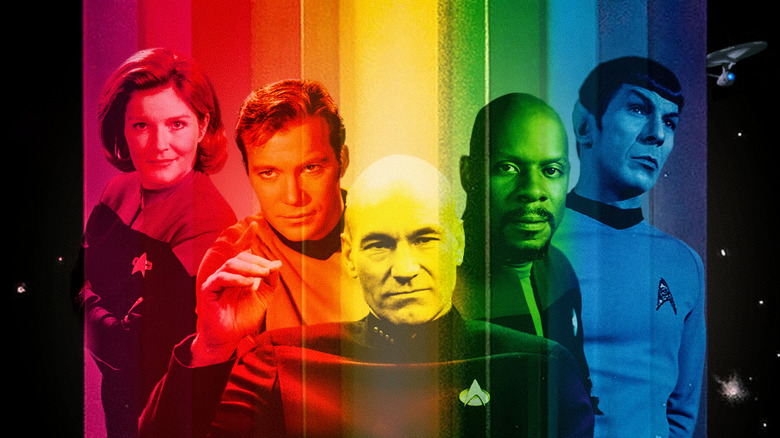
I can't say if I fell in love with "Star Trek," or if it fell in love with me.
Like many Trekkies, I came to "Star Trek" at an early age. Throughout the 1980s, reruns of the original series would air on my local station (KCOP, channel 13 in Los Angeles), and they would serve as a periodic video backdrop to our dinnertimes. As a child, "Star Trek" was merely an action-light, horror-heavy sci-fi adventure series, and my older sister and I would gleefully yell out when Spock (Leonard Nimoy) performed his notorious Vulcan nerve pinch, or when Captain Kirk (William Shatner) got to snog an itinerant babe. We would hide our heads from the monster of the week; like many, I was terrified by the scowling face of Balok, the Ted Cassidy-voiced puppet alien from "The Corbomite Maneuver" (November 10, 1966).
Perhaps unusually for a child, I wasn't powerfully drawn to action, fights, or explosions in my entertainment. I would indeed watch the era's toyetic wartime cartoons like "Transformers" and "G.I. Joe," of course, but I didn't care deeply for the characters, nor have much invested in their dramatic stakes. I had trouble taking the "oorah" action seriously, perhaps already innately understanding that the cartoon soldiers were fictional and their triumphs were only temporary; what is the meaning of a victory when the bad guys will merely return the following week?
I only realized this in retrospect, but "Star Trek" was secretly providing an antidote to the breathless mayhem oozing from every pore of my generation's childhood entertainment. It was a series that, despite bad guys, monsters, and fights, was ultimately teaching intense lessons of diplomacy and leadership. The crew of the Enterprise weren't "violent/cool," and I liked that. Finally, I realized, here was a show about pacifism.
Star Trek is a TV series about pacifism
And, yes, "Star Trek" communicated themes of pacifism. It might have been a fluke of 1960s special effects budgets, but "Star Trek" rarely showed the USS Enterprise firing off its weapons or getting into full-scale starship battles. The common playground pop culture query of "who would win in a fight?" seemed churlish with "Star Trek." Would Kirk win in a fight with, say, Han Solo? Even as a wee bairn, I had to ask why Kirk and Han Solo would be fighting in the first place. I figured Spock would merely ask Han Solo about his ship while Kirk invited him in for a meal. Power, "Star Trek" argued, wasn't derived from one's ability to dominate and overwhelm others with tactics and weapons prowess, but to negotiate, adapt, and remain friendly.
(It should be noted that I didn't see any "Star Wars" movies until I was 18 , perhaps key to my philosophical development.)
Whether "Star Trek" taught me to be a pacifist or whether I was already a pacifist can be debated, but creator Gene Roddenberry and I were definitely on the same wavelength. "Star Trek" took place in a post-war universe at a time when humans had outgrown the need to kill each other for resources, and petty political grievances were a thing of the past.
These themes became all the more explicit with the debut of "Star Trek: The Next Generation" in 1987. I was nine, and the premiere was a big event in our household. A new "Star Trek?" And one that took place almost a century after the last one? And it's even more aggressively devoted to themes of diplomacy, multiculturalism, and pacifism? Sign me up! It was all thrilling.
It was then that I realized a glorious thing: I am a nerd, and I love it.
Star Trek is for nerds, and that's a good thing
While it may be a cliché, I still maintain that "Star Trek" is for nerds. That is, I should hasten to add, a high compliment. With the release of "Next Generation," I was given my clearest, most refreshing draft of action-antidote. I began to realize that the rest of the American viewing public longed for conflict and war and action in their entertainment, with boys my age constantly raving about the latest 'splosion-fest that evoked the word "awesome."
Meanwhile, over on "Star Trek: The Next Generation," the universe had already graduated, moved into the stars, and gave up on action altogether. Oh sure, Commander Riker (Jonathan Frakes) was handy with a phaser, Worf (Michael Dorn) could murder you with a bat'leth, and the USS Enterprise-D needed to employ some sneaky battlefield tactics to outgun the Borg (or any number of other opponents), but one always got the sense that weapons and fights were a last-ditch tactic, a formality that must be seen through before an understanding could be reached. War was to be avoided at all costs.
What's more, there were classical references! Whenever Picard quoted Shakespeare , my heart would sing. By the time I turned 13 (when NextGen had just finished its fourth season), I too was getting into Shakespeare and Picard emerged as a teacher, a fictional professor that you didn't want to disappoint. I finally realized that the nerdy sci-fi technicalities of "Star Trek," along with its classical obsessions, workplace propriety, devotion to diplomacy, multicultural mindsets, and ability to brainstorm open-minded solutions to complex problems ... these were all aspirational states. Scoop in a few ethical dilemmas — racism, euthanasia, gender politics — and "Trek" gave me everything.
Star Trek obsession is healthy, actually
Like with the original series, the peacefulness of "Next Generation" could easily have been a product of its budget; without the money to stage massive phaser battles, fights and scrapes rarely rose above the skirmish level. This, by necessity, required the show to de-emphasize violence. The makers of "NextGen" also couldn't afford to visit alien worlds regularly, forcing them to shoot on the same six or seven sets week after week.
The limitations, however, allowed Trekkies to enjoy our time on board the Enterprise. "Star Trek" is, after all, a workplace drama above anything else, and we loved seeing the characters do their jobs on an day-to-day basis. We lived with the Enterprise crew long enough that we started to get a sense of how the ship worked. That, in turn, led directly into fantasies of living in "Star Trek," knowing we could operate the machinery if asked. It also didn't seem so terrible to live in a world that was devoted to science, peace, and diplomacy.
The natural outcropping of "Star Trek" obsession is, of course, the vast extant fan community. In the 1990s, "Trek" surged in the commercial marketplace, putting out books, models, pins, toys, and comics at a volume not seen before. If you wanted to delve into deep-cut expanded universe lore, there were millions of fans to help. I was a teen. I fell in hard. I purchased uniforms and decorations and read the books. As Gowron (Robert O'Reilly) so often implored , I experienced the glory.
Star Trek is a stop-gap to adult intellectualism
That fan obsession felt healthy to me. Yes, my fellow Trekkies and I had far too many nitpicky conversations about canon and character and what movies were or weren't the best (these kinds of conversations are not unique to "Star Trek" fandom), and those weren't always the most intellectually inspired conversations. It also wasn't lost on any of us that "Star Trek" took place in a post-capitalist, non-religious utopia, and Trekkies felt the need to spend their capitalist dollars in an expression of pop worship. We were a little embarrassed by it, but we embraced the irony.
The conversations became more complex with the launch of "Star Trek: Deep Space Nine" in 1993. Here was a "Star Trek" series that forced its utopian characters to live in a world of religion, turbulence, and wartime suffering. Could Starfleet retain its ideals when confronted with their opposite? The answer was: not always. In a way, "Deep Space Nine" was the most practical "Star Trek" series, offering a metaphor for Trekkies constantly butting heads with the outside world.
Just as Commander Sisko (Avery Brooks) had to wrangle the scheming machinations of militant Cardassians and the power-hungry preaching of corrupt Bajoran theocrats, so too did we Trekkies have to wield our optimism in the face of a greedy, war-hungry world. While others longed for violence, both real and fictional, we insisted on idealism and negotiation. Conflict resolution was better than saber-rattling. All of a sudden, my "Trek"-taught childhood optimism became a philosophical rallying cry. Maintaining peace isn't something that we can take for granted. Pacifism is an active, hammer-like philosophy we need to handle and express every day. The politics were clear.
The changing face of Star Trek fandom
By the end of the 1990s, I had left home to attend an out-of-state college, and my media consumption shifted dramatically. I fell out of "Star Trek" by necessity. It wasn't until several years later that I gathered the wherewithal — and collected the DVDs — to catch up. "Star Trek" ran hot and cold (some of those "Voyager" episodes were rough), but it was always careful to abide by its principles. Weirdly, the franchise's radical optimism couldn't survive the bleak, warmongering post-9/11 world . A series about diplomacy, reaching out to enemies, de-escalating conflicts, and non-weapons-oriented solutions wasn't welcome in the age of George W. Bush.
When J.J. Abrams' 2009 "Star Trek" reboot film came out, the franchise was altered to be one of the usual action flicks that "Trek" previously eschewed. It appealed to a mass audience. Conversations began as to what constituted "real Trek," leading directly into additional conversations about gatekeeping, fandom, and franchise evolution. Is "Star Trek" for nerds, or can it appeal to — for lack of a better term — jocks?
Conversations between Trekkies in the 1990s were impassioned, but rarely caustic (at least in my experience). In 2009, however, notions of fan toxicity were more openly acknowledged among pop obsessives, and people became angrier about their obsessions. All of a sudden, I was an "old school" Trekkie.
I was 31 and okay being "old school." After all, decades had passed since "Next Generation," a series that responded to Ronald Reagan and flourished during the 1990s. Why shouldn't it adjust again? I didn't like the franchise's actioned-up response to 9/11, but I was still happy to have debates as to what "Star Trek" meant and what modern action films communicated.
"Trek" taught me to negotiate ... about "Trek."
What Star Trek means today
I am on record with my feelings about the Paramount+ era of "Star Trek," and I have frequently been rather critical . I want to go on record, however, that my criticisms are not based in misplaced nostalgia, prejudicial hate against new "Star Trek," nor a gradually closing mind (an unfortunate affliction that can sometimes strike people rounding middle age). Indeed, I have liked a great deal of the "Star Trek" shows that have debuted since 2017. I think "Star Trek: Lower Decks" perfectly balances humor and irreverence with notable "Star Trek" themes of growth and maturity. "Lower Decks" is about lower-ranking officers who have the crappiest jobs on a Starfleet vessel, and struggle to grow up when they have a twentysomething's instincts toward laziness and bad decision-making. "Star Trek" is about adults, and "Lower Decks" sees people becoming adults.
Likewise, "Star Trek: Strange New Worlds" returns to an episodic structure, allowing for miniature dramas and handily-packaged morality plays to be presented more cleanly than the broad arcs of "Discovery" or "Picard." I only wince at "Star Trek" when it violates its own principles or lazily falls into action-based stories that (perhaps unwittingly) glorify combat, war, and aggression. And make no mistake, these kinds of stories were always part of the franchise; they didn't start in 2017.
I love "Star Trek" deeply because of its radical, aggressive optimism. It envisions a world, and a form of entertainment, that downplays conflict. Drama and power can come from elsewhere. The future, "Trek" always declared, was going to be populated by nerds, miracle tech, and egalitarianism. And what's so funny about peace, love, and understanding?
War was our awkward adolescence, "Trek" said, and our adulthood is in the stars.
Real-life 'Star Trek' planet was actually just an illusion caused by a 'jittery' star
New research shows that sometimes life imitates art, even in astronomy.
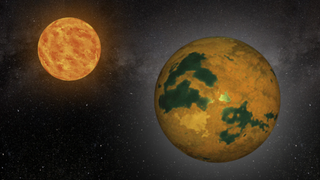
A planet beyond the solar system that has been compared to Spock's homeworld Vulcan in the Star Trek franchise may have been nothing more than an illusion caused by a jittery star.
The extrasolar planet or " exoplanet " (a term for a planet outside of our solar system) was proposed to orbit a star called 40 Eridani A or "Keid," which is part of a triple star system located around 16.3 light-years from Earth. In Star Trek, this star is also home to the planet Vulcan. First announced in 2018 , the planet caused quite a stir thanks to its similarities with Spock's fictional home planet.
A team of scientists led by astronomer Abigail Burrows of Dartmouth College now thinks that the "wobble" of this planet's parent star isn't the result of an orbiting world tugging on it at all. Burrows and colleagues discovered using a NASA instrument called NEID located at Kitt Peak National Observatory that the origin of this wobble is actually "pulses and jitters" of Keid itself.
Related: NASA space telescope finds Earth-size exoplanet that's 'not a bad place' to hunt for life
The fictional version of Vulcan was first introduced during Gene Roddenberry's seminal original series run of Star Trek , mentioned in the 1965 unaired pilot episode "The Cage." In the 2009 J.J. Abrams-directed Star Trek reboot , Vulcan was destroyed by a time-traveling enemy of Kirk, Spock, and the rest of the Enterprise crew.
By wiping out the real-life Vulcan, officially designated HD 26965 b, this new research shows that sometimes life imitates art.
Sorry Keid, you're on your own...
There are several ways to detect exoplanets orbiting distant stars, but the two most successful techniques are the transit method and the radial velocity method . Both of these techniques consider the effect an orbiting planet has on its star.
Get the Space.com Newsletter
Breaking space news, the latest updates on rocket launches, skywatching events and more!
The transit method, employed to great success by NASA's Transiting Exoplanet Survey Satellite (TESS) , measures the tiny dips in light a planet causes as it crosses the face of its parent star.
While the transit method is by far the more fruitful of these two exoplanet detection methods , the radial velocity method is useful for spotting exoplanets that don't pass between the face of their star and our vantage point in the solar system.
The radial velocity method uses tiny shifts in the light of a star as an orbiting planet gravitationally tugs on it. As a star is pulled away from Earth, the wavelength of the light it emits is stretched, causing it to move to the "red end" of the electromagnetic spectrum, a phenomenon called " redshift ." The converse happens when the star is pulled toward Earth, the wavelengths of light compress, and the light is "blue-shifted" toward the "blue end" of the electromagnetic spectrum.
This is analogous to the Doppler effect, which impacts sound waves on Earth. When an ambulance races toward us, the soundwaves from its siren are compressed, making them sound higher-pitched. When the ambulance races away, the sound waves are more spaced out, and the siren becomes lower-pitched.

The radial velocity method is best for detecting especially massive planets , as these exert a larger gravitational pull on their stars and thus generate a more pronounced shift in the starlight from that stellar body. However, it is less robust for detecting planets with masses lower than that of Jupiter, the solar system's most massive planet.
When HD 26965 b was first potentially detected using the radial velocity method, its mass was estimated to be about 8 times greater than that of Earth but less than that of Neptune, making it a so-called "super-Earth" planet. The faux-Vulcan was suspected to orbit its parent star at around 22% of the distance between Earth and the sun , completing a year in around 42 Earth days.
Yet even the scientists who discovered this planet warned that it could be a misdetection caused by Keid's inherent jitteriness. By 2023, researchers had cast major doubts on the existence of this exoplanet. These new high-precision radial velocity measurements, which were not yet available in 2018, are the final nail in the coffin of the Vulcan-like HD 26965 b.
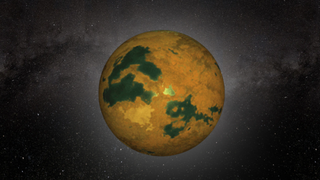
The disappointing news for Star Trek fans was delivered by NEID, the name of which rhymes with "fluid." NEID is an instrument that uses radial velocity to measure the motion of nearby stars with extreme precision.
NEID separated out the suspected planetary signal into its constituent wavelengths representing light emitted from various layers in the structure of Keid's surface or photosphere . This allowed the team to detect significant differences in the individual wavelengths compared to the total combined signal.
— Cotton candy exoplanet is 2nd lightest planet ever found
— Earth-size planet discovered around cool red dwarf star shares its name with a biscuit
— Star blows giant exoplanet's atmosphere away, leaving massive tail in its wake
The upshot is that the signal implied the existence of HD 26965 b is actually the result of something flickering at the surface of Keid approximately every 42 Earth days. This effect could also be created when hot and cold plasma rises and falls through Keid's convection zone and interacts with surface features like dark sunspot patches or bright, active regions called " plages ."
While this discovery isn't great news for Keid and its planetary prospects, or for fans of Star Trek, it is a positive step for exoplanet-hunting scientists.
That's because the finely tuned radial velocity measurements of NEID promise that planetary signals can be more accurately separated and distinguished from the natural jitters of stars in the future.
The team's research is published in The Astronomical Journal.
Join our Space Forums to keep talking space on the latest missions, night sky and more! And if you have a news tip, correction or comment, let us know at: [email protected].
Robert Lea is a science journalist in the U.K. whose articles have been published in Physics World, New Scientist, Astronomy Magazine, All About Space, Newsweek and ZME Science. He also writes about science communication for Elsevier and the European Journal of Physics. Rob holds a bachelor of science degree in physics and astronomy from the U.K.’s Open University. Follow him on Twitter @sciencef1rst.
Massive new NASA exoplanet catalog unveils 126 extreme and exotic worlds
NASA space telescope finds Earth-size exoplanet that's 'not a bad place' to hunt for life
NASA's James Webb Space Telescope mission — Live updates
Most Popular
- 2 That giant sunspot that supercharged auroras on Earth? It's back and may amp up the northern lights with June solar storms.
- 3 Doctor Who '73 Yards': Who exactly is that old woman following Ruby Sunday?
- 4 Euclid space telescope finds 1.5 trillion orphan stars wandering the Perseus cluster (images)
- 5 Bejeweled galaxy of 'Bernice's Hair' sparkles in new Hubble Telescope photo
UK Edition Change
- UK Politics
- News Videos
- Paris 2024 Olympics
- Rugby Union
- Sport Videos
- John Rentoul
- Mary Dejevsky
- Andrew Grice
- Sean O’Grady
- Photography
- Theatre & Dance
- Culture Videos
- Fitness & Wellbeing
- Food & Drink
- Health & Families
- Royal Family
- Electric Vehicles
- Car Insurance Deals
- Lifestyle Videos
- UK Hotel Reviews
- News & Advice
- Simon Calder
- Australia & New Zealand
- South America
- C. America & Caribbean
- Middle East
- Politics Explained
- News Analysis
- Today’s Edition
- Home & Garden
- Broadband deals
- Fashion & Beauty
- Travel & Outdoors
- Sports & Fitness
- Sustainable Living
- Climate Videos
- Solar Panels
- Behind The Headlines
- On The Ground
- Decomplicated
- You Ask The Questions
- Binge Watch
- Travel Smart
- Watch on your TV
- Crosswords & Puzzles
- Most Commented
- Newsletters
- Ask Me Anything
- Virtual Events
- Betting Sites
- Online Casinos
- Wine Offers
Thank you for registering
Please refresh the page or navigate to another page on the site to be automatically logged in Please refresh your browser to be logged in
Planet thought to be like Spock’s Vulcan is an astronomical illusion
Signal indicating presence of planet may have been flickering of star 40 eridani a, article bookmarked.
Find your bookmarks in your Independent Premium section, under my profile

Sign up to our free weekly IndyTech newsletter delivered straight to your inbox
Sign up to our free indytech newsletter, thanks for signing up to the indytech email.
A planet thought to be similar to Star Trek character Spock ’s fictional home planet Vulcan is an astronomical illusion caused by the pulses and jitters of a star, a new study has found.
The discovery of a planet orbiting the star 40 Eridani A, made famous by Star Trek , drew excitement when it was first announced in 2018.
But new measurements using a Nasa instrument installed on Arizona’s Kitt Peak a few years ago have led to the conclusion that the planet does not exist.
In fact, even the study which noted the existence of planet Vulcan had cautioned that it could be messy jitters from the star masquerading as a planet.
The new research, described in The Astronomical Journal , used highly precise measurements of radial velocity, not yet available in 2018, to confirm that the caution about the discovery was justified.
Radial velocity instruments rely on the Doppler effect whereby shifts in the light spectrum of a star can reveal its wobbling motions.
Astronomers tracked small shifts in light from 40 Eridani A and measured how it “wobbled” as the gravity of an orbiting planet tugged at it.
After analysing the data, they came to the conclusion that the “planet” signal that was previously detected may have been the flickering of the star’s surface.
The signals previously recorded were likely the roiling of hotter and cooler layers beneath the star’s surface, called convection, combined with the star’s surface features similar to sunspots.
This robs star 40 Eridani A of its possible planet Vulcan, at least for now.
Join our commenting forum
Join thought-provoking conversations, follow other Independent readers and see their replies
Subscribe to Independent Premium to bookmark this article
Want to bookmark your favourite articles and stories to read or reference later? Start your Independent Premium subscription today.
New to The Independent?
Or if you would prefer:
Want an ad-free experience?
Hi {{indy.fullName}}
- My Independent Premium
- Account details
- Help centre

- Mirror Universe
- View history
The Vulcans , or Vulcanians , [1] were a warp-capable humanoid species from the planet Vulcan . They were widely renowned for their strict adherence to logic and reason as well as their remarkable stoicism.
In 2161 , their homeworld became a founding member of the United Federation of Planets . ( TOS : " Mudd's Women ", " Amok Time "; TNG : " Encounter at Farpoint ", " Data's Day ", " Gambit, Part II "; Star Trek: First Contact ; ENT : " Broken Bow ", " Zero Hour ", " Awakening ", " These Are the Voyages... ") Vulcans were known by the Borg as Species 3259 . ( VOY : " The Raven ")
- 1.1 Mirror universe
- 1.2 Alternate reality
- 2.2 Medical conditions
- 2.3 Hybridization
- 3.2 Education
- 3.3 Logic and emotions
- 3.4 Attitudes to deception
- 3.5 Spirituality
- 3.6 Romantic relationships
- 3.7 Food and drink
- 3.8 Holidays
- 3.9 See also
- 4 Science and technology
- 5 Individuals
- 6.1 Appearances
- 6.2 Background information
- 6.3 Apocrypha
- 6.4 External links
History and politics [ ]
In 2154 , T'Pol stated that Vulcans had evolved on Vulcan. ( ENT : " The Forge ") Roughly a century later , however, Spock theorized that the Vulcans might be descendants of the Arretans . ( TOS : " Return to Tomorrow ") According to Narek , the myth of Ganmadan dated back to before the Romulan and Vulcan ancestors first arrived on Vulcan. ( PIC : " Et in Arcadia Ego, Part 2 ") In 2369 , evidence was discovered that several species including the Romulans , and therefore also the Vulcans, could be traced back to DNA that had been seeded on many planets by ancient humanoids 4.5 billion years ago . ( TNG : " The Chase ")
The Vulcans were once an extremely violent and emotional people (even by Earth standards) who waged almost constant warfare on one another. ( ENT : " Impulse ", " Awakening "; TOS : " Balance of Terror ", " Let That Be Your Last Battlefield "; VOY : " Random Thoughts "; SNW : " A Quality of Mercy ") Paranoia and homicidal rage were common. ( ENT : " Impulse ") They believed in a variety of gods , such as war, peace, and death . ( TNG : " Gambit, Part II ") As their level of technology increased, the Vulcans eventually reached a point where their violent nature threatened the extinction of their own species. ( ENT : " Awakening ")
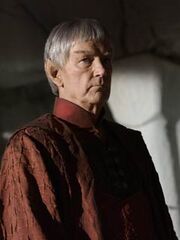
Surak, father of Vulcan logic
In an effort to avoid this fate, a Vulcan named Surak developed a new philosophy , thereby igniting the Time of Awakening . Surak maintained that the root cause of all the problems on Vulcan lay in the uncontrolled outpouring of the people's emotions. His followers swore to live their lives by an ethical system devised by Surak and based purely on logical principles. Emotions were to be controlled and repressed. ( TAS : " Yesteryear ")
Although this new philosophy spread rapidly across Vulcan, a minority, many of whom were known as "those who march beneath the raptor 's wings ", rejected Surak's ideals. A destructive war began, including the use of atomic bombs , and among the victims was Surak himself. ( ENT : " The Forge ", " Awakening ")
Eventually, however, those who opposed logic left Vulcan and founded colonies elsewhere ( TNG : " Gambit, Part I ", " Gambit, Part II ") – most notably on the planet Romulus , where they founded what eventually became the Romulan Star Empire . ( TOS : " Balance of Terror ", " The Enterprise Incident "; TNG : " Unification I ", " Unification II ") At some point in history, the Romulans and the Vulcans engaged in a hundred-year-long war against one another. The war was instigated by the actions of a member of the Q Continuum . ( VOY : " Death Wish ")
Another group that rejected Surak's philosophy was known as the " V'tosh ka'tur ", or "Vulcans without logic". The V'tosh ka'tur believed in controlling emotions by allowing themselves to actively experience them rather than suppressing them. Some of these also left Vulcan, and took up a nomadic existence. ( ENT : " Fusion ") Many turned to crime, however, and subsequently sent for rehabilitation at facilities such as the Ankeshtan K'til Retreat . ( SNW : " Spock Amok ", " The Serene Squall ") A prime example of a V'tosh ka'tur was Sybok , who underwent failed rehabilitation at Ankeshtan K'Til for involvement in piracy before ultimately trying to use emotion rather than logic to find answers to the creation of the universe. ( SNW : " The Serene Squall "; Star Trek V: The Final Frontier )

First contact with Humans in 2063
The Vulcans conducted a series of survey missions to the Sol system , as early as 1957 . ( ENT : " Carbon Creek ") Vulcans were, in fact, one of the first species to develop warp drive , though a century passed between the first warp flight and the breaking of the warp 2 barrier . ( ENT : " First Flight ") T'Pol told Archer that Vulcans "don't share" Humans ' "enthusiasm for space exploration," but a Syrrannite on Vulcan later advised Archer that this may not have been true. ( ENT : " Fight or Flight ", " The Forge ")
The official First Contact between Vulcans and Humans came on April 5 , 2063 , when a Vulcan survey ship , the T'Plana-Hath , detected the warp flight of Zefram Cochrane 's Phoenix . The Vulcans met with Cochrane at his launch site on the day following the flight. ( Star Trek: First Contact )
Subsequently, the Vulcans offered their technological guidance to Humans, but were criticized on Earth for holding back their development. ( ENT : " First Flight ", " Broken Bow ") A century after First Contact, the High Command had become worried about Humans, who, like Vulcans, had had devastating wars, but after which had rebuilt and started traveling to the stars much faster. There were those on the High Command who wondered what Humans would achieve in the century to come, and did not like the answer. ( ENT : " The Forge ")
By the mid- 22nd century , Vulcan culture had strayed from the path that Surak had originally laid out for them, to the point that Surak's katra did not recognize it as the culture he had helped to create. They had ceased being explorers and the High Command, once devoted to that goal, had instead become involved in a conflict with the neighboring Andorians . ( ENT : " Awakening ", " The Forge ")
The Vulcan High Command used an ancient monastery at P'Jem as a secret listening post to spy on the Andorians until June 2151 , when the listening post was discovered by the Andorians and a landing party from Enterprise NX-01 . Later, the Humans helped negotiate a peace between the Vulcans and Andorians over a disputed class D planetoid known to the Vulcans as Paan Mokar . ( ENT : " The Forge ", " The Andorian Incident ", " Cease Fire ")
Vulcans also became less tolerant of political and philosophical challenges towards the High Command's operations, notably engaging in purges of the Syrrannite group, who claimed that Vulcan society was no longer following the teachings of Surak. These tensions came to a head in a crisis called the Vulcan Reformation , which resulted in the overthrow of the High Command (and its leader, V'Las , who was secretly allied with the Romulans), as well as a restructuring of the Vulcan government including the dissolution of the High Command. T'Pau became a minister in this government. A less aggressive policy towards Earth was also adopted. ( ENT : " The Forge ", " Awakening ", " Kir'Shara ", " United ")
By the 21st and 22nd centuries, the Vulcans had also made contact with the Cardassians , Trill , Tholians , Klingons (as early as 2016 ), and scores of other races. ( DS9 : " Destiny "; ENT : " Broken Bow ", " Future Tense ")
As of the 23rd century , Vulcan had never been conquered in its collective memory. That memory went so far back that Vulcans could not conceive of a conqueror. ( TOS : " The Immunity Syndrome ")
By the 24th century , Vulcan remained one of the principal Federation members, and was deeply involved at all levels of that society. Vulcans were present in the Federation colonies found within the Demilitarized Zone established between the United Federation of Planets and the Cardassian Union by the terms of the Federation-Cardassian Treaty of 2370 ; they were among the colonists' representatives during discussions with the Cardassians concerning terrorist attacks by the anti-Cardassian Maquis movement established in the Zone. At least one Vulcan, Sakonna , acted as a gun runner and interrogator for the Maquis and made use of her people's ability to mind meld in the latter role. ( DS9 : " The Maquis, Part I ", " The Maquis, Part II ")
The Vulcans' tradition of exploration continued; in the 24th century, a Vulcan ship was the first to make formal contact with a Gamma Quadrant civilization, upon encountering the Wadi . ( DS9 : " Move Along Home ") The Vulcans were at the forefront of exploration in the Gamma Quadrant, encountering the Rakhari and finding the remains of the Hur'q civilization. ( DS9 : " Vortex ", " The Sword of Kahless ") In the 24th century, the Vulcan ministry of security was known as the V'Shar . ( TNG : " Gambit, Part II ")
By 2369, the Vulcans had a saying known to the Federation: " We're here to serve. " ( DS9 : " Captive Pursuit ")
Despite the enmity between the Federation and the Romulan Star Empire, some Vulcans attempted to forge a more cordial relationship with their cousins, ultimately hoping to reunify the two cultures. Many of these efforts met with little success. ( TNG : " Unification I ", " Unification II ")
Mirror universe [ ]
History turned out much differently for the Vulcans of the mirror universe . When the Vulcans made first contact with Earth of this universe in 2063, Zefram Cochrane shot the first Vulcan to publicly set foot on Terran soil, believing his vessel to be the vanguard of an intended invasion. The Terrans stormed the T'Plana-Hath and studied Vulcan technology. Eventually, the Vulcans were conquered by the Terran Empire . ( ENT : " In a Mirror, Darkly "; DIS : " Die Trying ")
By the 2150s , Vulcans were considered slaves to Terrans and not treated as equals. Vulcans later participated in a rebellion against the Empire in the 2250s . By 2267 , the half-Vulcan Spock had become first officer of a starship and eventually rose to the top of the Terran Empire itself. After the Empire was conquered by the Klingon-Cardassian Alliance , Vulcans served as slaves to the Klingon-Cardassian Alliance. Using fans, several of them cooled the Intendant aboard Terok Nor . ( ENT : " In a Mirror, Darkly, Part II "; TOS : " Mirror, Mirror "; DS9 : " Crossover ")
Some Vulcans, such as Tuvok , joined the Terran Rebellion . ( DS9 : " Through the Looking Glass ")
Alternate reality [ ]
In the alternate reality , the planet Vulcan was destroyed by a Romulan named Nero in 2258 . Over six billion Vulcans were killed, with an estimated ten thousand survivors. After witnessing the atrocity, Spock noted in his log that the Vulcan species had become endangered . ( Star Trek ) Spock's prime reality counterpart founded a colony for the survivors, which, by the following year, had been settled and named New Vulcan . ( Star Trek Into Darkness )
Physiology [ ]
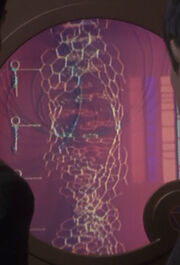
Scan of a Vulcan's DNA
Species which shared some physiological and behavioral traits with Vulcans were categorized as Proto-Vulcan humanoids . One example of this were the Mintakans . ( TNG : " Who Watches The Watchers ") In addition, Rigelian physiology was very similar to that of Vulcans. ( TOS : " Journey to Babel ")
Vulcans were generally similar to Humans in appearance, distinguished mainly by their pointed ears and upswept eyebrows. Their skin color was most commonly pale with a bronze or greenish tint, though some had brown skin. Vulcan physiognomy could resemble Humans of European , Asian , or African descent. ( Star Trek: The Original Series ; Star Trek III: The Search for Spock ; Star Trek: Voyager )
Most Vulcans had straight, glossy black hair , though brown and/or curly hair was also possible. Vulcans had body hair similar to Humans, and some males could be very hirsute. Vulcan males were capable of growing facial hair , but most chose to shave it. ( TOS : " Mirror, Mirror ", " Patterns of Force "; Star Trek V: The Final Frontier ; VOY : " Year of Hell "; ENT : " In a Mirror, Darkly, Part II "; Star Trek )
Vulcan teeth included anterior tricuspids , which could be protected from decay for decades by sealing them with a trifluorinate compound . ( ENT : " Dear Doctor ")
In contrast to their external similarities, Vulcan internal anatomy differed radically from that of Humans. For instance, their heart was where a Human's liver would normally be, ( TOS : " Mudd's Women ", " A Private Little War ", " The Omega Glory "; Star Trek Beyond ) and beat several hundred times per minute. ( TOS : " The Naked Time ", " Journey to Babel ") Vulcans also had no appendix . ( TOS : " Operation -- Annihilate! ") They did, however, have mitochondria . ( TNG : " Data's Day ")
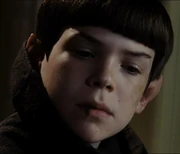
A greenish bruise
Vulcan blood was copper -based and was copper- or rust-colored when deoxygenated in the veins and green when oxygenated, in the arteries, or when bleeding. Bruises and dermal abrasions took on a greenish color. ( TOS : " The Naked Time ", " Obsession ", " Patterns of Force "; DS9 : " Field of Fire "; VOY : " Repression "; ENT : " Shadows of P'Jem ", " In a Mirror, Darkly, Part II ")
Vulcan body chemistry used little, if any, sodium chloride compared to that of Humans. ( TOS : " The Man Trap ")
Vulcans possessed a highly efficient respiratory system to extract the oxygen they needed from Vulcan's thin atmosphere . They were most comfortable in high temperatures. A Vulcan of advanced age could become more sensitive to lower temperatures. ( TOS : " The Deadly Years "; ENT : " The Forge ")
The Vulcan digestive tract was highly adaptable. Although alien foods , notably Human food, would occasionally disagree with a Vulcan, given time, their body could adapt to the alien food. ( ENT : " Unexpected ")
Vulcan hearing was very sensitive. ( TOS : " Return to Tomorrow ", " The Way to Eden "; ENT : " Singularity ") Vulcan females possessed a heightened sense of smell . ( ENT : " Broken Bow ", " The Andorian Incident ")
Having evolved on a planet which was mostly desert , Vulcans developed ways of surviving in desert conditions. For example, they could survive for several days without water and had inner eyelids which protected their eyes . ( TOS : " Operation -- Annihilate! "; ENT : " Strange New World ", " The Forge ")
Vulcans had a superior metabolism to Humans. Caffeine and sapotoxins had little effect on them. ( ENT : " Breaking the Ice ") They were also capable of surviving for long durations without food or sleep. Under stress, Vulcans could do without sleep for weeks. ( TOS : " The Paradise Syndrome ") Tuvok once claimed that, as a Vulcan, he was capable of going without sleep for two weeks, although, shortly after making this claim, he fell asleep in the command chair after having gone a little over ten days without sleep. ( VOY : " Muse ")
Vulcans were, on average, three times physically stronger than Humans, and had considerably faster reflexes. ( DS9 : " Take Me Out to the Holosuite ")
Vulcans were very sensitive to nitrous oxide gas , which rapidly rendered them unconscious. ( TAS : " The Practical Joker ")
Vulcans typically had a lifespan of two hundred years or more. Their aging was correspondingly slower; a Vulcan of age 65 had the appearance of a 20th century Human in their late 20s, and was considered in their "quarter-life". ( ENT : " Broken Bow ", " Zero Hour "; TNG : " Sarek "; LD : " Empathological Fallacies ")
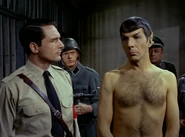
A medical scan of Soval's brain

A medical scan of Spock's brain
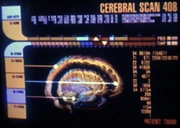
A medical scan of Tuvok's brain
Perhaps the most interesting aspect of the Vulcan physiology was the brain . The Vulcan brain was described by The Doctor as " a puzzle , wrapped inside an enigma , housed inside a cranium . " ( VOY : " Riddles ") Indeed, The Doctor has also noted how " the Vulcan brain never ceases to amaze me. " ( VOY : " Blood Fever ")
A Vulcan's brain was in direct control of most of the bodily functions, acting as a control unit for many organs. Despite this, a Vulcan body from which the brain had been removed was capable of functioning and even walking around (albeit in a zombie-like state) with a portable life support system. ( TOS : " Spock's Brain ")
Unlike most humanoid species, traumatic memories were not only psychologically disturbing to Vulcans, but had physical consequences as well. The Vulcan brain, in reordering neural pathways, could literally lobotomize itself. ( VOY : " Flashback ")
Vulcans learned to gain conscious control of many of these functions, allowing them to regulate their bodies to a high degree by simple will-power. When injured, a Vulcan could go into a trance-like state, using this ability to concentrate all of his or her energy on repairing the injury. ( TOS : " A Private Little War ") However, Vulcans did have certain levels of pain they were unable to suppress, forcing them to endure the experience. ( VOY : " Resistance ")
This trance could be self-induced and gave the physical appearance of near-death. It was similar, in principle, to Vulcan neuro-pressure techniques which could be used to relax the mind and body. ( TOS : " By Any Other Name "; VOY : " Riddles "; ENT : " The Xindi ")
The substance trellium-D acted as a neurotoxin to Vulcans, destroying the neural pathways which controlled their emotions. Treatment had to be provided quickly after exposure; otherwise, the damage was irreversible. ( ENT : " Impulse ")
The most famous aspect of the Vulcan brain were the inherent telepathic abilities, such as the mind meld . Vulcans were natural touch-telepaths. Though considerable training was required to utilize this ability to the fullest (like performing the fal-tor-pan ), simpler contacts did not require any concentration, training, or even conscious knowledge of the act. ( VOY : " Blood Fever ")
Vulcans called focal points in the bioelectric field of the brain qui'lari . ( DS9 : " The Muse ")
Stronger minds were capable of non-contact telepathic projection and scanning, usually over short distances, ( TOS : " The Devil in the Dark ", " The Omega Glory "; VOY : " Random Thoughts ", " Prey ") but sometimes even over interstellar distances. ( TOS : " The Immunity Syndrome "; Star Trek: The Motion Picture ; DIS : " Lethe " )
Another psionic ability of the Vulcan race was the telepathic suggestion or compulsion, consciously performed by Spock, ( TOS : " Dagger of the Mind ", " A Taste of Armageddon ", " The Omega Glory ") Sybok , ( Star Trek V: The Final Frontier ) Tuvok, ( VOY : " Repression ") and T'Pol, ( ENT : " In a Mirror, Darkly ") and unconsciously performed by Sarek. ( TNG : " Sarek ")
Although Vulcans did not, typically, allow themselves to experience uncontrolled strong emotions, they could sense them in others. ( ENT : " Fallen Hero ")
Vulcans were capable of performing a synaptic pattern displacement , or the transfer of one individual's consciousness into another. ( Star Trek III: The Search for Spock ; DS9 : " The Passenger ")
The psycho-suppression system responsible for the Vulcan suppression of emotions was located in the mesiofrontal cortex . ( VOY : " Meld ")
Approximately every seven years, adult Vulcans had to endure pon farr , the Vulcan mating period. It was marked by intense emotions and primal urges (known as plak tow , or "blood fever") that could kill the Vulcan if not satisfied. Physiological symptoms included elevated dopamine levels and fever . For such an orderly society of quiet sobriety, the madness which accompanied the outbreak of pon farr was an unavoidable evil. ( ENT : " Bounty ", " In a Mirror, Darkly "; TOS : " Amok Time "; VOY : " Blood Fever ")
Medical conditions [ ]
There were several diseases from which the Vulcan species suffered, including:
- Pa'nar Syndrome
- Tuvan Syndrome
- Bendii Syndrome
- Choriocytosis
Hybridization [ ]
Vulcans and Humans could not reproduce without medical intervention according to 2150s medical knowledge. ( ENT : " E² ", " Demons ", " Terra Prime ")
In 2155, Terra Prime extremists created a binary clone from T'Pol and Trip Tucker . The child, whom they called Elizabeth , had many genetic flaws due to the method of her creation and she died. ( ENT : " Demons ", " Terra Prime ")
In 2230, Spock was born on Vulcan to Sarek and Amanda Grayson . ( ENT : " Terra Prime "; TOS : " Journey to Babel ", " The Squire of Gothos "; Star Trek Beyond )
The Vulcan heritage in Vulcan-Human hybrids was dominant, with copper-based blood, pointed ears, and the full range of Vulcan abilities.
Society and culture [ ]
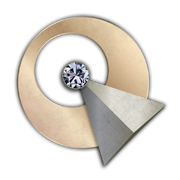
IDIC, the Vulcan national symbol
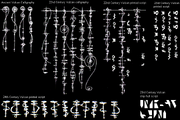
Six different Vulcan scripts
Vulcans were generally non-violent, but logic dictated that combat was sometimes necessary. Vulcans could and did use weapons and practiced martial arts called tal-shaya and Suus Mahna . ( TOS : " Journey to Babel "; ENT : " Marauders "; DIS : " Context Is for Kings ")
Vulcans considered death to be the completion of a journey. Therefore, they did not fear it happening; however, the loss of one's katra was to be avoided if possible, since the katra lived on beyond the physical death. ( Star Trek III: The Search for Spock ) They also practiced euthanasia for the infirm and elderly, and saw nothing wrong with practicing ritual suicide when they reached a certain infirmity with age. ( VOY : " Death Wish ") As they knew death was an inevitability, they believed that fear of death was ultimately illogical. ( Star Trek Beyond )
The government on Vulcan was a representative democracy . Individual political advancement was based on meritocratic principles. ( ENT : " Awakening ")
Although Vulcans were highly integrated into the Federation, in the 23rd century, some Vulcans viewed service in Starfleet to be less prestigious than attending the Vulcan Science Academy , ( TOS : " Journey to Babel ") though in the twilight years of that century, this apparently became much less of an issue. ( VOY : " Flashback ") Furthermore, among all the Federation members whose people served in Starfleet, Vulcans were the only ones to be accommodated with starships crewed entirely by their own species, such as the USS Intrepid and the USS T'Kumbra . ( TOS : " The Immunity Syndrome "; DS9 : " Take Me Out to the Holosuite ")
Vulcans played a game known as kal-toh . ( VOY : " Alter Ego ", " The Omega Directive ", " Endgame ")
Vulcans had a traditional funeral dirge . ( VOY : " Tuvix ")
Vulcans occasionally gave gifts . However, Vulcan custom did not include receiving a gift back from a recipient. ( Star Trek Beyond )
Vulcans possessed family names , although they were pronounceable by Humans only after many years of practice. ( TOS : " This Side Of Paradise ", " Journey to Babel ")
Many Vulcan females had names beginning with "T'" and particularly "T'P" ( T'Pol , T'Pring , T'Pau , T'Mir , T'Pel, T'Pan), but not all ( Valeris , Sakonna , Saavik , Selar ); many males had names beginning with "S" ( Spock , Sarek , Sybok , Surak , Stonn , Soval ); again, though, there was variation ( Tuvok , Lojal , Vorik , Taurik , Koss ).
Education [ ]
Naturally, the development of a Vulcan's lifelong devotion towards logic was encouraged at a very early age. Vulcan parents utilized careful and gentle methods to train their infants in primary logic. ( VOY : " Human Error ") Vulcan children learned, by example, how to detach themselves from their emotions as well, and it often aided in difficult childhood situations. ( ENT : " Fusion ", " Home "; TAS : " Yesteryear "; VOY : " Innocence ", " Gravity ") Despite logic being paramount in education, Vulcan children were allowed much freedom as well, and enjoyed a number of passions their controlled states allowed them to coordinate.
As parents, Vulcans never restricted their children from real life. Doing so only hindered their ability to develop their own identity. A Vulcan parent's attachment to their children could not be described as an emotion. They were part of the parent's identity and the parent was incomplete without them. ( VOY : " Innocence ")
Children at Vulcan nursery schools danced. ( TOS : " Whom Gods Destroy ")
When they were older, they learned in skill domes . The Vulcan Learning Center employed these. ( Star Trek , DIS : " The Vulcan Hello ", " Battle at the Binary Stars ")
A Vulcan program suitable for young children which taught basic problem solving skills was available at Deep Space 9 's school in 2370 . ( DS9 : " Whispers ")
The Vulcan Science Academy and Vulcan Medical Institute were two notable post-secondary institutions.
Logic and emotions [ ]
Contrary to stereotype, Vulcans possess strong emotions. They use meditation as a way to suppress those emotions. For instance, emotions like remorse, relief, joy, and embarrassment were all displayed by Spock when he thought Captain Kirk was dead and then saw him alive. ( TOS : " Amok Time "). Indeed, Vulcan emotions were far more intense, violent, and passionate than those of many other species, including even Humans. ( TNG : " Sarek ")
It was this passionate, explosive emotionality that Vulcans blamed for the vicious cycle of wars which nearly devastated their planet. As such, they focused their mental energies on mastering them. The essence of their logical society was in arriving at the truth through logical process. Emotions were illogical, thus making them impure, and deterrent to truth. Vulcans were born with the same emotions that afflicted their violent ancestors, but continual mental conditioning generally gave them the impassivity they sought. ( TAS : " Yesteryear ")
Though not all could arrive at the ultimate pure logical state, the exacting process of mental control gave Vulcans enough to conform to the ideals of Vulcan society. The ultimate level of logical thought was achieved through the attainment of kolinahr , which was said to purge them of all remaining emotions. ( Star Trek: The Motion Picture )
Attitudes to deception [ ]
Vulcans were renowned for their honesty, and indeed it has been claimed that "Vulcans could not lie ." However, they would do so for what they perceived as logical reasons, though they rarely referred to their dishonesty as "lying." ( TOS : " The Enterprise Incident "; Star Trek II: The Wrath of Khan ; Star Trek VI: The Undiscovered Country ) For instance, an elder denied the existence of technology and spies at the monastery at P'Jem in order to protect an ongoing surveillance operation. ( ENT : " The Andorian Incident "). Also, T'Pol's second foremother directly lied to another Vulcan, telling the commander of a rescue party that her crewmate had died in a crash, so that he could remain on Earth to "study" Humanity. ( ENT : " Carbon Creek ")
In 2259 of the alternate reality, Spock managed to deceive Khan Noonien Singh into transporting armed torpedoes aboard the USS Vengeance , as Khan believed they still carried members of his crew . Khan wasn't aware that Spock had anticipated his betrayal and removed Khan's crew from the torpedoes with the intent to detonate them and cripple the Vengeance . When Khan stated that he'd know if they weren't his, Spock assured him that " Vulcans do not lie " and that " the torpedoes were his ". This demonstrated that Vulcans, while still technically telling the truth, didn't always necessarily tell the entire truth if it was to their advantage. ( Star Trek Into Darkness )
Tuvok at one point stated, when responding to Seven of Nine questioning him as to whether Vulcans were capable of lying " we are capable of telling lies. However, I have never found it prudent or necessary to do so. " ( VOY : " Hunters ")
T'Rina , the President of Ni'Var as the Vulcan homeworld was renamed by the 32nd century , showed a willingness to lie in 3191 , engaging in an elaborate deception to Primarch Ruhn of the Breen Imperium while negotiating with him. ( DIS : " Erigah ")
Spirituality [ ]
The Vulcans held a number of spiritual beliefs. Their religious system was polytheistic . They also believed in the katra , the soul and consciousness of a person, which could be transferred psionically prior to death. ( TAS : " Yesteryear "; Star Trek II: The Wrath of Khan ; Star Trek III: The Search for Spock ; TNG : " Gambit, Part I "; ENT : " The Forge ", " Awakening ")
Meditation was a central component of Vulcan life. The Vulcan Sh'vhal type ship of the late 24th century was known to feature a dedicated meditation chamber that the crew could use alone or in small groups. ( LD : " wej Duj ")
What little is known about Vulcan religious beliefs indicates that, beginning prior to the "Time of the Awakening", they were polytheistic. Surak 's teachings became the primary focus of Vulcan spirituality/mysticism, but, as late as the 23rd century, it was still not unheard of to find Vulcans honoring the traditional gods. There were, however, no demons in Vulcan literature. ( TAS : " Yesteryear "; TNG : " Gambit, Part I "; VOY : " Heroes and Demons ")
Romantic relationships [ ]
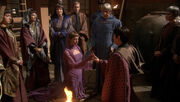
Vulcan wedding ceremony

Vulcan ceremonial wedding grounds, circa 2260s
When Vulcan children came of age, having sometimes been betrothed to childhood companions by age seven, underwent the pon farr , the link compelled them to follow through with full marital rituals, which cemented their relationship. ( TOS : " Amok Time "; ENT : " Breaking the Ice ")
It was traditional for the female to propose marriage by presenting a necklace to the male. She may signal her intention to do so by wearing ritual mating colors on an auspicious date, such as the anniversary of a first courtship event . ( SNW : " Strange New Worlds ")
If, for whatever reason, the female did not wish to go through with the marriage, then the ceremony of koon-ut-kal-if-fee ("marriage or challenge") was invoked. The male fought for the right to keep his mate against a challenger of her choosing. The female became the property of the male who won the contest, unless he chose to release her. The koon-ut-kal-if-fee was a fight to the death. ( TOS : " Amok Time ")
As of 2266 , hearsay held that Vulcan men treated their women strangely. ( TOS : " The Naked Time ")
According to Spock, it was "undignified for a woman to play servant to a man that is not hers" as his reason for throwing food (from Nurse Chapel) against the wall. ( TOS : " Amok Time ") Yet, a century earlier, T'Pol brought Jonathan Archer food and blankets in sickbay, and in an alternate timeline, tended to him as a nursemaid ( ENT : " A Night in Sickbay ", " Twilight ").
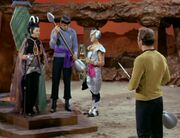
Vulcan wedding ceremony, ca 2260s
Touching each other with both the middle- and the forefinger was a custom practiced by married couples and was part of the Vulcan marriage ceremony. ( TOS : " Journey to Babel "; VOY : " Bliss "; ENT : " Home ") It could also help to calm down male Vulcans during pon farr . ( Star Trek III: The Search for Spock )
Food and drink [ ]
Although not always, most Vulcans were primarily vegetarians . They also did not touch food with their hands unless wearing special gloves. ( ENT : " Broken Bow ", " Home ") The v'tosh ka'tur were a major exception, however. ( ENT : " Fusion ")
Vulcans were fermenting wines , notably Vulcan port , during the 21st century. ( DS9 : " The Maquis, Part I ")
Guests in a Vulcan household were expected to rise before sunrise to prepare the morning meal. ( ENT : " Home ") Plomeek broth was considered a traditional Vulcan breakfast. ( ENT : " Unexpected ")

Holidays [ ]
See also [ ], science and technology [ ].
- Vulcan starships
- Vulcan starship classes
Individuals [ ]
- List of named Vulcans
- List of unnamed Vulcans
Appendices [ ]
Appearances [ ].
A list of all appearances of Vulcans (excluding the regular appearances of Spock , Tuvok , and T'Pol ):
- " Amok Time " (Season Two)
- " Mirror, Mirror "
- " Journey to Babel "
- " The Savage Curtain " ( Excalbian recreation only) (Season Three)
- " Yesteryear " (Season One)
- " The Time Trap "
- Star Trek: The Motion Picture
- Star Trek II: The Wrath of Khan
- Star Trek III: The Search for Spock
- Star Trek IV: The Voyage Home
- Star Trek V: The Final Frontier
- Star Trek VI: The Undiscovered Country
- Star Trek Into Darkness
- Star Trek Beyond
- " Encounter at Farpoint " (Season One)
- " The Last Outpost "
- " Coming of Age "
- " Symbiosis "
- " Conspiracy "
- " The Outrageous Okona " (Season Two)
- " The Schizoid Man "
- " A Matter Of Honor "
- " The Dauphin "
- " Shades of Gray " (footage from "The Dauphin")
- " The Ensigns of Command " (Season Three)
- " Yesterday's Enterprise "
- " Captain's Holiday "
- " Ménage à Troi "
- " Qpid " (Season Four)
- " Ensign Ro " (Season Five)
- " Unification II "
- " Unification I "
- " The First Duty "
- " Imaginary Friend "
- " Suspicions " (Season Six)
- " Gambit, Part I " (Season Seven)
- " Gambit, Part II "
- " Lower Decks "
- " Preemptive Strike "
- Star Trek Generations
- Star Trek: First Contact
- Star Trek: Insurrection
- Star Trek Nemesis
- " Emissary " (Season One)
- " The Nagus "
- " The Forsaken "
- " The Maquis, Part I " (Season Two)
- " The Maquis, Part II "
- " Crossover "
- " Through the Looking Glass " (Season Three)
- " Shakaar "
- " The Visitor " (Season Four)
- " Homefront "
- " Bar Association "
- " Rules of Engagement "
- " Shattered Mirror "
- " For the Cause "
- " Broken Link "
- " Trials and Tribble-ations " (Season Five)
- " Rapture "
- " Behind the Lines " (Season Six)
- " Favor the Bold "
- " Valiant "
- " Image in the Sand " (Season Seven)
- " Afterimage "
- " Take Me Out to the Holosuite "
- " Prodigal Daughter "
- " The Emperor's New Cloak "
- " Field of Fire "
- " Caretaker " (Season One)
- " Persistence of Vision " (illusion only) (Season Two)
- " Alter Ego " (Season Three)
- " Fair Trade "
- " Blood Fever "
- " Darkling " (hologram only)
- " Day of Honor " (Season Four)
- " Extreme Risk " (Season Five)
- " In the Flesh " ( Species 8472 posing as Vulcan)
- " Counterpoint "
- " Gravity "
- " Bliss " (illusion only)
- " Repression " (Season Seven)
- " Flesh and Blood " (hologram only)
- " Body and Soul " (hologram only)
- " Renaissance Man "
- " Endgame "
- " Broken Bow " (Season One)
- " The Andorian Incident "
- " Breaking the Ice "
- " Shadows of P'Jem "
- " Fallen Hero "
- " Carbon Creek " (Season Two)
- " Shockwave, Part II "
- " Dead Stop "
- " The Seventh "
- " Cease Fire "
- " First Flight "
- " The Expanse "
- " Impulse " (Season Three)
- " Twilight "
- " Home " (Season Four)
- " The Forge "
- " Awakening "
- " Kir'Shara "
- " In a Mirror, Darkly "
- " In a Mirror, Darkly, Part II "
- " Terra Prime "
- " The Vulcan Hello " (Season One)
- " Battle at the Binary Stars "
- " Choose Your Pain "
- " Si Vis Pacem, Para Bellum "
- " Into the Forest I Go "
- " The Wolf Inside "
- " The War Without, The War Within "
- " Will You Take My Hand? "
- " Brother " (Season Two)
- " Light and Shadows "
- " If Memory Serves "
- " Project Daedalus "
- " The Red Angel "
- " Perpetual Infinity "
- " Through the Valley of Shadows "
- " Such Sweet Sorrow "
- " Such Sweet Sorrow, Part 2 "
- " Unification III " (Season Three)
- " That Hope Is You, Part 2 "
- " Anomaly (DIS) " (Season Four)
- " Choose to Live "
- " All Is Possible "
- " ...But to Connect "
- " Rubicon "
- " The Galactic Barrier "
- " Rosetta "
- " Species Ten-C "
- " Coming Home "
- " Q&A " (Season Two)
- " Maps and Legends " (Season One)
- " The End is the Beginning "
- " Nepenthe "
- " Broken Pieces "
- " Et in Arcadia Ego, Part 1 "
- " Et in Arcadia Ego, Part 2 "
- " The Star Gazer " (Season Two)
- " Farewell "
- " The Next Generation " (Season Three)
- " Disengage "
- " Seventeen Seconds "
- " No Win Scenario "
- " Imposters "
- " Dominion "
- " Surrender "
- " The Last Generation "
- " Second Contact " (Season One)
- " Much Ado About Boimler "
- " Veritas "
- " Kayshon, His Eyes Open " (Season Two)
- " Mugato, Gumato "
- " An Embarrassment Of Dooplers "
- " wej Duj "
- " First First Contact "
- " The Least Dangerous Game " (Season Three)
- " Hear All, Trust Nothing "
- " The Stars At Night "
- " Twovix " (Season Four)
- " In the Cradle of Vexilon "
- " Something Borrowed, Something Green "
- " Empathological Fallacies "
- " A Few Badgeys More "
- " The Inner Fight "
- " Old Friends, New Planets "
- " Kobayashi " (hologram) (Season One)
- " Supernova, Part 2 "
- " Strange New Worlds " (Season One)
- " Spock Amok "
- " The Serene Squall "
- " Ad Astra per Aspera " (Season Two)
- " Charades "
- " Under the Cloak of War "
Background information [ ]
The Vulcans were the first alien species created for Star Trek by Gene Roddenberry . ( " The Andorian Incident ", text commentary , ENT Season 1 DVD special feature )
^ The term "Vulcanian" has been described as an " Obsolete term meaning a native of the planet Vulcan. The term 'Vulcan' has come to mean both the planet and the native of same. " ( Star Trek Concordance , p. 248) The origin of the term from a production standpoint dates to 1966 , when NBC prepared a twelve-page booklet, entitled "Advance Information on 1966- 67 Programming: Star Trek ", which described the series' regular crewmembers. The description of Spock mentions that his father was a native of "Vulcanis," and his people were known as the "Vulcanians". ( The Star Trek Compendium , p. 25) As a result of early "growing pains" in the writing staff, the term "Vulcanian" was used sporadically (and sometimes interchangeably) during the first season , where it was heard in " Mudd's Women ", " Court Martial ", " A Taste of Armageddon ", " This Side of Paradise ", and " Errand of Mercy ". The Bajorans suffered similar "growing pains" when they were briefly known as the "Bajora" during their early appearances. The name "Vulcan" itself, in reference to the people, was first heard in " The Naked Time ". See also: Vulcanian expedition and Vulcanian Scientific Legion of Honor .
In notes that Costume Designer Robert Fletcher wrote about the various aliens in the film Star Trek: The Motion Picture , he included a description of the Vulcans. After pointing out the Vulcans were "from tv series", the brief continued as follows:
" Observed in the movie as Mr. Spock, others among crew, and the Masters on Vulcan planet scene. Unemotional, scientific people, their culture based on cold logic, reason and control. One of the Federation's most advanced races [....] Vulcans are mostly tall, slender, beautiful people, with strong sense of honor. Physically distinguished by upswept eyebrows and pointed ears. Their green blood is copper-based. "
Fletcher also imagined that, because their homeworld was rich in jade, the Vulcans made extensive use of that substance, such as with ruby jewellery and a red-colored giant statue is visible on the planet's surface, in the film. ( The Making of Star Trek: The Motion Picture , p. 133)
The depiction of Vulcans developed with the introduction of Tuvok on Star Trek: Voyager , as he was the first black Vulcan main character. In developing the character of Tuvok, the series' creators tried to put a new spin on the long-established alien species. However, Executive Producer and series co-creator Jeri Taylor later stated, " Subsequently I have learned we were not the first. In the third feature there was a black Vulcan priestess, so it was clearly established there were different colors of people on Vulcan. " (Taylor's statement is not entirely true, as the black Vulcan priestess was actually in the fifth Star Trek film, Star Trek V: The Final Frontier .) When he was cast as Tuvok, actor Tim Russ was an expert on Vulcans, and, in fact, his expertise of portraying a member of the species got him the part. ( Cinefantastique , Vol. 27, No. 4/5, pp. 59 & 60) " People are always asking me how there could even be a black Vulcan, " said Russ, shortly after the start of VOY Season 1 . " If Vulcans are humanoids and other humanoids were the species they most often encountered, then logic would follow that because of genetic mutation and random selection, you're going to have different colors and different variations of the species at one time. So, Tuvok is a black Vulcan. " ( The Official Star Trek: Voyager Magazine issue 2 , p. 20)
In a story idea that the Star Trek: Deep Space Nine writers had that eventually became the two-parter " Homefront " and " Paradise Lost ", the Vulcans were to withdraw from the Federation. The cause of this schism was to be their concern that the Federation was becoming too concerned with the Changeling infiltration at the cost of civil liberties. Starfleet was to assume incorrectly that the Founders had infiltrated Vulcan society. ( Star Trek: Deep Space Nine Companion (p. ? ))
In developing the Vulcans for Star Trek: Enterprise , Brannon Braga noted " one of our goals with this series was to make the Vulcans interesting again. I think they've been taken for granted... I think the Vulcans in this era are very complicated and paradoxical and make good antagonists. " ( Star Trek: The Magazine Volume 3, Issue 2 , p. 10) Regarding the depiction of crazed Vulcan crewmembers of the starship Seleya in ENT : " Impulse ", Braga once remarked, " I loved the idea of Vulcan zombies. " ( Star Trek: Communicator issue 151 , p. 29)
In the unproduced animated series Star Trek: Final Frontier , set in the far future, the Vulcans left the Federation at some point in the 25th century to discuss reunification with the Romulans.
In an ultimately unused line of dialogue from the script of Star Trek , Spock explained, " 'Cthia' is the stricture that binds our emotions... but few of us are that perfectly Vulcan. " [4]
For Star Trek Into Darkness , Vulcan ear prosthetics, in encapsulated silicone, were created by makeup artist David Snyder . A few changes were made to the Vulcan ears when compared to those from the previous film , Star Trek , on which Snyder had also worked. David LeRoy Anderson , the Makeup Department Head for Into Darkness , explained, " Our modifications were strictly mechanical, based on Dave's desire to make the application a little easier. Dave did a clay press of the existing sculpt and remodeled the ears to help mass-produce the pieces, and that gave us great edges. " The ears were applied by Snyder, using a cotton swab, and (at least in the case of Zachary Quinto as Spock ) a tiny amount of acetone. ( Cinefex , No. 134, p. 77)
Apocrypha [ ]
According to Star Fleet Medical Reference Manual (published in 1977 by "Star Fleet Productions, Inc."):
- Males height = 2.0 meters (6'6")
- Males weight = 70 kilograms (154.3 lbs)
- Females height = 1.7 meters (5'6")
- Females weight = 50 kilograms (110.2 lbs)
- Body temperature = 32.78 °C (91 °F)
- Heart rate = 242 bpm
- Blood pressure = 80/40
Vulcan blood vessels are more dilated than those of Humans. The larger blood vessels are the reason Vulcan blood pressure is lower. The dilated blood vessels and fast heart rate also play a key role in regulating Vulcan body temperature. A standard 91 °F body temperature is maintained by the internal cooling mechanism of fast blood circulation. ( Star Fleet Medical Reference Manual )
Vulcans do not have sweat glands, and cannot rely on evaporation as a means of cooling their bodies in the harsh heat of their planet's desert climate. Expelling heat through radiation is insufficient. Vulcans evolved an internal cooling mechanism. With an average body temperature of 91 °F, the high blood flow circulates cool blood throughout their body. ( Star Fleet Medical Reference Manual ) This systematic means of cooling gives credence to McCoy's comment "that green ice water you call blood." ( TOS : " The Paradise Syndrome ")
While " Little Green Men " implies that Vulcans were not warp-capable until at least 1947, in the novel Prime Directive they already possessed such technology in 1908: a Vulcan survey ship was responsible for the mysterious Tunguska event , redirecting a large meteor about to hit Western Europe – where it would have killed millions and done irreparable damage to Human civilization – so that it instead impacted in an area so remote that no Human deaths were recorded.
External links [ ]
- Vulcan at Memory Beta , the wiki for licensed Star Trek works
Screen Rant
10 times star trek was referenced on supernatural.

Your changes have been saved
Email Is sent
Please verify your email address.
You’ve reached your account maximum for followed topics.
The 12 Most Important Supernatural Episodes That Defined The Show
Tng ended star trek’s redshirt joke for good, supernatural: 10 best dean quotes.
- Supernatural's lasting impact is evident through its extensive references to pop culture, especially Star Trek, reflecting its passionate cult following.
- Various episodes of Supernatural cleverly incorporate nods to Star Trek, showcasing the show's attention to detail and fondness for the iconic series.
- By seamlessly weaving Star Trek elements into its storylines, Supernatural pays homage to the beloved franchise and connects with fans on a deeper level.
Throughout its remarkable 15 seasons, Supernatural contained countless references to other television shows and films, but The CW series had a particular love for Star Trek . Following brothers Sam (Jared Padalecki) and Dean (Jensen Ackles) Winchester as they traveled around the country hunting monsters, Supernatural gained a passionate cult following similar to the Star Trek fandom. As the resident pop culture aficionado, Dean was always quick with a sarcastic remark or relevant reference for nearly any situation. With its talented cast and compelling storylines, Supernatural spanned genres and became the longest-running American live-action fantasy TV series, with 327 episodes.
Since Star Trek: The Original Series began in 1966, the Star Trek franchise has become a pop culture phenomenon. Characters like Captain James T. Kirk (William Shatner) and Mr. Spock (Leonard Nimoy) have become so ingrained in popular culture that even those with little knowledge of Star Trek can recognize them. Star Trek has since spawned numerous films and television shows and produced some of the most iconic science fiction stories of all time. It's no surprise then, that references to Star Trek and its characters have been popping up in other films and television shows for decades. Here are 10 times Supernatural has nodded to Star Trek.
Supernatural has more than 300 episodes in the series run, but a few of these episodes completely change the tone and course of the entire series.
10 The Vulcan Mind Meld
Supernatural season 1, episode 6 - "skin".
As Sam and Dean investigate a suspicious murder, they realize the culprit is a shapeshifter who can look like anyone. When the shapeshifter captures Sam and Dean, it takes on the appearance of the older Winchester, which gives the being access to Dean's memories. As Sam explains the situation to the real Dean (who had been unconscious), he says: "It was like he was downloading your thoughts and memories."
Dean replies, "You mean, like the Vulcan mind meld?," to which Sam agrees it was "something like that." Throughout Star Trek , Spock and other Vulcans have used the Vulcan mind meld to share their thoughts and gain a better understanding of others. Unlike a mind meld, the shapeshifter's ability only worked one way and the creature used it as a means of control.
In another surprising Star Trek connection, "Skin" was directed by none other than Robert Duncan McNeill who played Lt. Tom Paris in Star Trek: Voyager.
9 The USS Enterprise
Supernatural season 4, episode 3 - "in the beginning".
When the angel Castiel (Misha Collins) sends Dean back in time to 1973, he encounters the younger version of his parents. Initially, Dean has no idea where (or when) he is, and he heads to a nearby diner and sits down next to a young man, who is later revealed to be his father, John Winchester (Matt Cohen). Still unaware that he has traveled back in time, Dean tries to use his cell phone, but of course has no reception in 1973.
Dean turns to John and asks: "Know where I can get any reception?" John looks at Dean's 21st-century flip phone and says: "The USS Enterprise?" Dean soon realizes he has been transported back in time and sets out to learn more about his young parents. Considering how popular Star Trek reruns were in the early 1970s, it makes perfect sense that John would liken Dean's phone to a Star Trek communicator .
8 The Holodeck
Supernatural season 4, episode 22 - "lucifer rising".
In the Supernatural season 4 finale, a high-ranking angel named Zachariah (Kurt Fuller) whisks Dean away to a location he calls a "Green Room" to keep him safe until it's time for him to play his role in the apocalypse. Zachariah tries to tempt Dean with different diversions, encouraging him to wait patiently. Dean, however, refuses Zachariah's suggestions, saying: "No, no. Let's bail on the holodeck, okay?"
Introduced in Star Trek: The Next Generation, Star Trek's holodeck allowed people to virtually visit any real or fictional location they could imagine. Since Zachariah offers to conjure up all manner of distractions for Dean, his "Green Room" could be seen as its own kind of holodeck. Dean, however, has grown fed up with the angels, and he doesn't get to experience any holodeck-like illusions.
7 Redshirts
Supernatural season 6, episode 13 - "unforgiven".
When Sam and Dean investigate a series of missing persons, Sam remembers that he had previously worked a similar case with his resurrected grandfather, Samuel Campbell (Mitch Pileggi). In flashbacks, Sam and Samuel hunt a monster known as an Arachne by using the local sheriff as bait to lure the creature. When Sam suggests this course of action, Samuel questions him saying, "So, what, Roy's just some redshirt to you, just spider bait?"
Sam replies that this is his backup plan, but Samuel notes how cold Sam has become. During this time, Sam had been missing his soul after a brief stint in Hell. Without his soul, Sam did not experience emotions like empathy, and he had no problems using the sheriff to catch the monster. Samuel's reference to a "redshirt" refers to the disposable security officers who were often killed on away missions in Star Trek: The Original Series.
Star Trek is infamously known for killing off officers wearing red, but Star Trek: The Next Generation actually put an end to this trope in 1987.
6 Speaking Klingon
Supernatural season 8, episode 10 - "torn and frayed".
As Dean and Castiel investigate a strange occurrence involving a burning bush, they interview the badly burned witness. He reports that the bush spoke to him, but when Castiel asks what the voice said, the man replies: "No clue. Sounded like Klingon to me." Dean then asks the man to repeat what the bush said and he responds that it sounded like "sol-voch-tay."
While this does sound like a Klingon word, Castiel reveals that it is actually an Enochian word that means obey. As Enochian is a language unique to angels, Castiel reasons that this particular angel must be desperate to communicate via burning bush. Since their introduction in Star Trek: The Original Series, Star Trek's Klingons have become one of the franchise's most iconic aliens, and their language has a full alphabet and English translations.
5 Holodeck, Part 2
Supernatural season 7, episode 2 - "hello, cruel world".
As Sam continues to experience hallucinations of Lucifer (Mark Pellegrino) , he struggles to differentiate reality from what is only in his mind. As Dean tries to convince Sam that he's real and Lucifer is the hallucination, he asks his brother: "Why would the devil holodeck you a whole new life, when he could just kick your ass all over the cage?"
After the end of Supernatural season 5, Sam spent time trapped in a cage in Hell with Lucifer, and he continues to feel the effects of that experience. With his reference to the holodeck, Dean suggests that there would be no reason for Lucifer to create an elaborate fictional life for Sam if he were really still trapped in the cage. As Dean points out, the "post-apocalyptic mess" they are currently living in would be the worst type of holodeck adventure.
4 Planet Vulcan
Supernatural season 4, episode 21 - "when the levee breaks".
As Supernatural season 4 comes to a close, Dean and his uncle Bobby Singer (Jim Beaver) try to help Sam overcome his addiction to demon blood. Sam and Dean have different ideas about preventing the impending apocalypse, and Dean chooses to align with the angels rather than the demons. When Bobby questions why Dean trusts the angels, Dean replies that he doesn't, adding that "they come on like shady politicians from planet Vulcan."
Dean points out that an alliance with the "shady" angels is still better than letting Sam trust a demon. Although Sam is often considered the "nerdier" of the two brothers, Dean makes the most references to Star Trek and other movies and franchises throughout Supernatural. Dean clearly knows enough about Trek to liken the often difficult-to-read angels to the ever-logical Vulcans.
Dean is the funny one of CW's Supernatural. Some of his quips and one liners have become iconic to fans and before it ends, we have his 10 best quotes
3 Live Long & Prosper
Supernatural season 7, episode 20 - "the girl with the dungeons and dragons tattoo" & season 8, episode 11 - "larp and the real girl".
Introduced in Supernatural season 7, Felicia Day's Charlie Bradbury quickly became a fan-favorite character, with her fun personality and nerdy interests. As Sam and Dean work to stop the dangerous Leviathan, Charlie uses her computer skills and connections to help the two brothers. When Charlie says goodbye to Sam and Dean, she offers them a Vulcan salute.
Charlie returns several times throughout the show, and Sam and Dean learn more about her geeky interests, which include Star Wars and Lord of the Rings . Like Dean, Charlie often references television shows and films, and she eventually becomes like a young sister to the Winchesters. She regularly uses the Vulcan "Live Long and Prosper" salute as a means to say goodbye.
2 Khan Worms
Supernatural season 6, episode 16 - "...and then there were none".
In this tense episode of Supernatural, Sam, Dean, and their uncle Bobby face off against a parasitic worm-like creature that Dean refers to as "a Khan worm on steroids." The worm could enter a person's body through their ears or mouth and then control them. Once the worm has left the person, they had no memory of what they had done while under its influence.
Never given an official name, these creatures were referred to as Khan worms from that point forward. In Star Trek II: The Wrath of Khan , Khan Noonien Singh (Ricardo Montalban) used similar burrowing worm-like creatures called Ceti eels to manipulate Commander Pavel Chekov (Walter Koenig) . The eel larvae could crawl into a person's ear and make them extremely susceptible to suggestion.
1 Save The Whales
Supernatural season 6, episode 18 - "frontierland".
In the Supernatural episode "Frontierland," Dean realizes that he and Sam need to travel back in time to acquire the ashes of a Phoenix. When Dean explains the plan, he excitedly says: "We’ll Star Trek IV this b*****." While Sam gives his brother a blank look, their uncle Bobby responds that he only watched Star Trek: Deep Space Nine . Dean shakes his head, saying: " It’s like I don’t even know you guys anymore. Star Trek IV. Save the whales."
The original line had Bobby saying he only watched Star Trek: The Next Generation, but actor Jim Beaver requested the line be changed to DS9 because his late wife Cecily Adams had portrayed the Ferengi Ishka on that show.
In the end, Dean lays out his plan to travel back to 1861 to get what they need, and the brothers call on their angel friend Castiel to send them back in time. Star Trek IV: The Voyage Home, of course, follows Kirk, Spock, and their crew as they travel back in time to the 1980s to find two humpback whales they can bring back to save Earth of the future. Dean Winchester may not seem like a typical Trekkie, but he shouts out Star Trek numerous times over Supernatural's fifteen seasons.
Supernatural is available to stream on Netflix.
Every live-action Star Trek show is available to stream on Paramount+.
Star Trek IV: The Voyage Home is available to stream on Max.
Supernatural
Created by Eric Kripke, Supernatural is a fantasy/drama series that premiered in 2005. The series follows the adventures of Dean and Sam Winchester - two men wronged by supernatural beings as children who now spend their days investigating and hunting demons, ghosts, and monsters across the United States.
Star Trek: The Original Series
Star Trek: The Original Series follows the exploits of the crew of the USS Enterprise. On a five-year mission to explore uncharted space, Captain James T. Kirk (William Shatner) must trust his crew - Spock (Leonard Nimoy), Dr. Leonard "Bones" McCoy (Forest DeKelley), Montgomery "Scotty" Scott (James Doohan), Uhura (Nichelle Nichols), Chekov (Walter Koenig) and Sulu (George Takei) - with his life. Facing previously undiscovered life forms and civilizations and representing humanity among the stars on behalf of Starfleet and the United Federation of Planets, the Enterprise regularly comes up against impossible odds and diplomatic dilemmas.
Jonathan Frakes on Directing ‘Star Trek’: Looking Back on ‘Discovery’ & Ahead to ‘Strange New Worlds’ Season 3
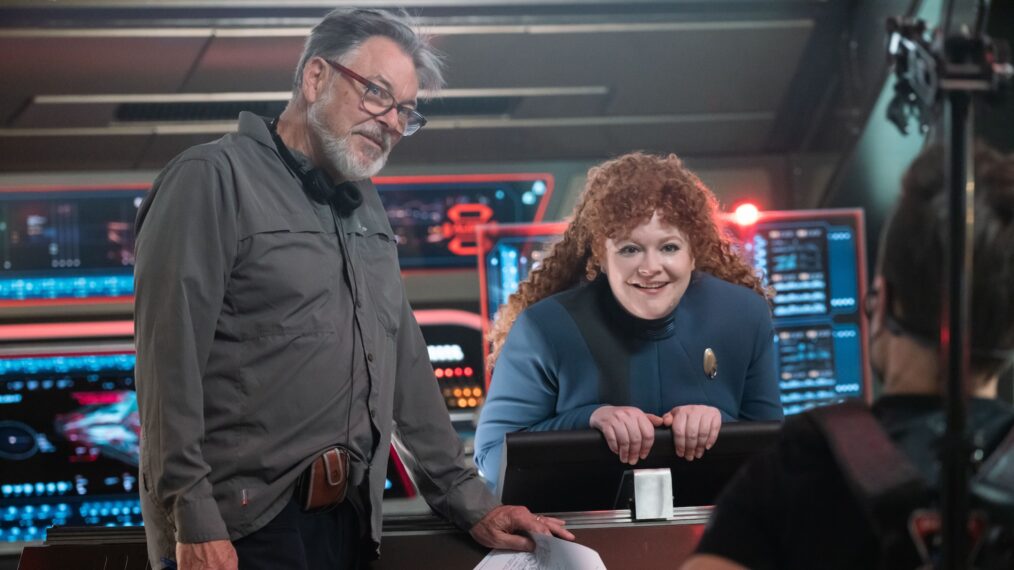
For Star Trek: Discovery ‘s penultimate episode, an icon from the franchise stepped behind the camera: Jonathan Frakes , who starred as Riker on Star Trek: The Next Generation and reprised the role on Picard .
And for him, it was just returning to a set he enjoys, for his eighth episode behind the camera on Discovery . In the episode, members of the crew infiltrate the Breen ship in hopes of getting their hands on a key piece of tech for their mission to find the Progenitors’ power. But even amidst the action, there’s time for some emotional beats.
Below, Frakes takes us inside the episode, looks back on Discovery , and teases a Strange New Worlds Season 3 episode he directed.
What excited you about this script as a director?
Jonathan Frakes: There’s a lot more action than I’m usually given, and the whole direction, if you will, of the season was that we find more action and more levity, two of my favorite parts of the business. So I was thrilled. The ending where the ship literally flies in the tailpipe of another ship I thought was really ambitious and great to storyboard and a beautifully executed by JZ [Jason Zimmerman] and all of our friends over at the visual effects department, but also the contrast between—Burnham [ Sonequa Martin-Green ] and Book [ David Ajala ] have a story that they clearly have not found time to sort out about their relationship. They’re in the midst of all this chaos. And, the B story, the wonderful story with our Kelpian and our Vulcan with Doug [Jones] and Tara [Rosling] is so beautiful that they’re in love and about to get married during the chaos of this fight with the Breen. So the contrasts of tone were very interesting to me.
I was going to point to Michael and Book’s conversation because it’s with their helmets on, so talk about directing that emotional scene.
Yeah, Maya Bankovic was my cinematographer on that. We desperately needed a way to see their faces because I mean, I get the Breen all look alike. I get they all wear helmets, and I get that that’s the premise of the show and it’s already been established, but it’s very hard for the audience to know who’s who. I can see that Burnham’s a little shorter than Book, but I mean, they’re all wearing ridiculous helmets and costumes, and so we found a way to take the liberty of having what we would call a camera inside the helmet where we could literally see their faces. And when we tested that and everybody approved that, that let us breathe a little more easily, that when we had intimate conversations while they were pretending to be Breen, we could actually shoot it like a tight closeup. So that certainly helped.

Wilson Cruz Recalls 'Star Trek: Discovery' Audition & Being 'Formidable Enough'
But there’s very little time in this story for them to [talk], and she pulls him aside in the middle of this chaos in the Breen hallways to just give them a little taste—because she didn’t have a chance. She saw him in engineering and wasn’t able to have a private moment. Then they had the meeting where they decided who was going to go there, and there was no real private moment there. I think that was a great part of the writing, that there was so much going on that these two lead characters whose lives have been altered by the information that Michael got in 508 at the library was… I think you’re waiting as an audience member, she’s got to say something to her about this, doesn’t she?
We’ve also been following Adira’s ( Blu del Barrio ) journey as they find their place, and we get to see them step into that a bit in this episode going on this mission. There’s also a slight sense of dads seeing their kid off to college when they’re leaving.
Yeah, I think that’s enabled by Tilly [ Mary Wiseman] . Tilly has been a mentor to Adira in a way that, in addition to Culber [ Wilson Cruz ] and Stamets [Anthony Rapp] being parents, the three of them have encouraged that character to embrace their confidence, if you will. And I thought that was a very sweet little walk and talk where the three of them are walking down, like dropping them off for college. That’s a good metaphor for it. And the stiff upper lip that they took was, “I’ll be fine dad, don’t worry. I’ll be back.” And I think it was very relatable.
You mentioned that ship flying into the other ship…
That was all storyboard and we talked about it and the chaos of all that, but I didn’t get to execute any of that except shooting the plates for it. Also, that whole green ship was on the AR wall, which is a trip in itself, that set when it’s that exciting and that incredibly detailed. It’s changed filmmaking, these AR walls; instead of imagining what might be on a green screen behind you, you’re literally in a volume that has everything that the actors need and what the filmmakers need, what the camera needs to tell the story. So many of the visual effects that are not put in later, they’re put in as part of the extensive and expensive planning of the AR wall set. And that was a very successful version of that I thought.
What scene did you have the most fun directing?
I like the scene in the ready room where Burnham puts the pieces together and the decision sort of in the moment, “Well, I’m going to go and you’re going to go and you’re going to go and you’re going to go, and that’s how we’re going to do this.” I loved Burnham’s decision making. Also, I was crazy about Callum [Keith Rennie] at the end, pacing, pacing, pacing, pacing, pacing, and then deciding again in the moment, “Here’s what we’re going to do.” I like when the leaders make powerful decisions with confidence, and both of those scenes reflected that.
You’ve directed across Trek series. What have you found that’s unique to Discovery that you enjoy directing?
I have a special fondness for Discovery because it was the first Star Trek after the old ones that I was asked back onto, so that family of actors reminded me a lot of our family on Next Gen . So I have a real soft spot [for them]. [They went through] what we were going through on our Season 1, which is now we’re part of this Star Trek universe, what does this really mean? And they were the first ones back. I mean, they opened up this whole new wave of Star Trek . So there was a certain skepticism that I warned them about. I was like the elder who’d come to town to tell what it’s going to be like. I said, “Your lives are going to change.” And that’s what DeForest Kelley told me, and it was true. They did, and they have, and I think we’re all very grateful to be part of this family.
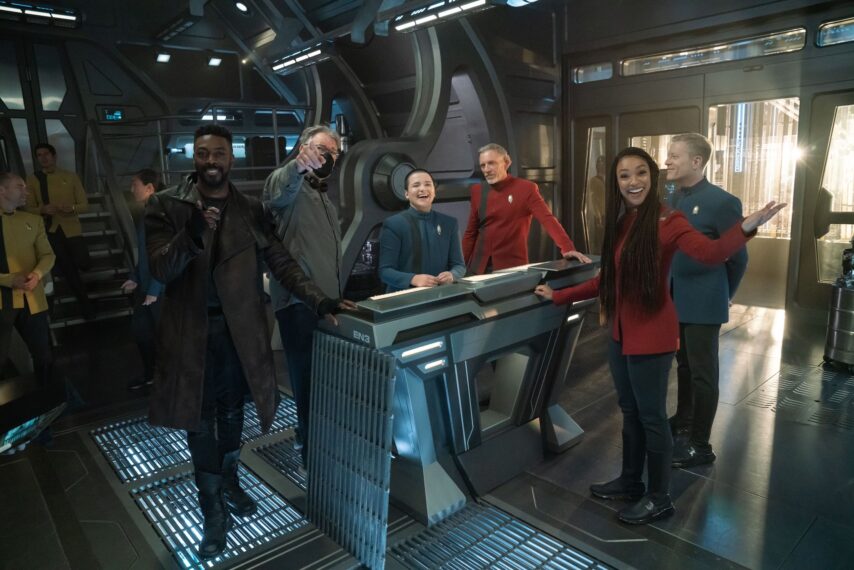
Michael Gibson / Paramount+
You’ve directed eight episodes of Discovery . What are you going to miss about this show?
I’m going to miss Sonequa. I’m going to miss Doug. I’m going to miss Anthony. I’m going to miss Tunde [Olatunde Osunsanmi]. There’s a lot of people over there that I have built long professional and personal relationships with. The cast is quite something. Mary. I mean, I remember when Blu first arrived and Anthony Rapp and I had the first scene with them in the corridor, and it was so clear to us that the talent that this actor had brought from one of the schools in London and Anthony and I had this moment where we looked at each other because both of us had been doing it a long time, and it was so clear like, “Holy s**t, this one really gets it,” and it’s been true. So watching them grow has been spectacular for me. As always, it’s all about the people. There’s nobody better as a leader than Sonequa.
Picard had that great next generation reunion, which I loved. Could we see you as Riker again? Have you heard anything?
I haven’t heard anything, but I’m available.
What else is coming up for you? What else have you directed that’s still to come?
I just finished a fabulous episode of Strange New Worlds that we actually finished editing last week, so that’s for next season. And I’ve got a couple of pilots that I’m trying to get developed and up and out, and I’ve got my son’s wedding that we’re planning and I’ve got a whole pile of conventions to go to, and then I’ll look forward to Starfleet Academy , which is coming up in the fall.
You said Strange New Worlds . Anything you can say about that?
I can say that it is maybe the best episode of TV I’ve had the privilege of directing. The story, as you’ll see, ends up being a Hollywood murder mystery, and that’s about all I’m allowed to leak.
Star Trek: Discovery , Series Finale, Thursday, May 30, Paramount+
Star Trek: Strange New Worlds , Season 3, TBA, Paramount+
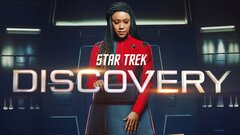
Star Trek: Discovery where to stream
Star Trek: Strange New Worlds where to stream
Star trek: discovery, star trek: strange new worlds, jonathan frakes.

Benefits to Registering & Following
(It's free!)
share this!
May 28, 2024
This article has been reviewed according to Science X's editorial process and policies . Editors have highlighted the following attributes while ensuring the content's credibility:
fact-checked
peer-reviewed publication
trusted source
The death of Vulcan: Study reveals planet is actually an astronomical illusion caused by stellar activity
by Pat Brennan, NASA
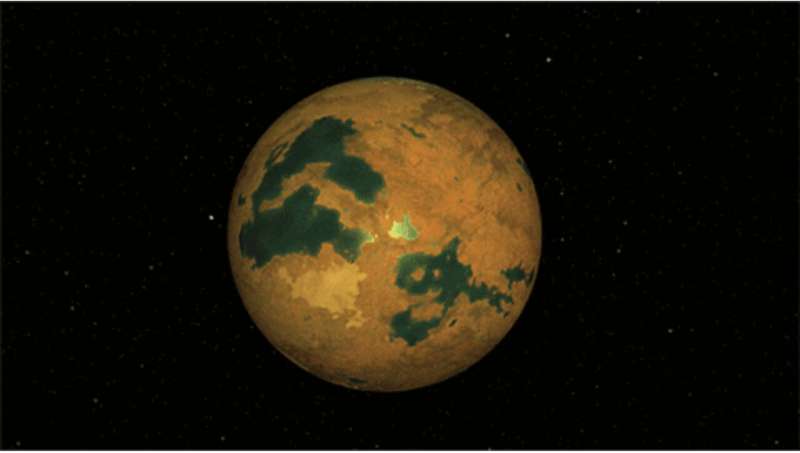
A planet thought to orbit the star 40 Eridani A—host to Mr. Spock's fictional home planet, Vulcan, in the "Star Trek" universe—is really a kind of astronomical illusion caused by the pulses and jitters of the star itself, a new study shows.
A science team led by astronomer Abigail Burrows of Dartmouth College, and previously of NASA's Jet Propulsion Laboratory, has published a paper describing the new result, titled "The death of Vulcan: NEID reveals the planet candidate orbiting HD 26965 is stellar activity," in The Astronomical Journal . (Note: HD 26965 is an alternate designation for the star 40 Eridani A.)
The possible detection of a planet orbiting a star that Star Trek made famous drew excitement and plenty of attention when it was announced in 2018. Only five years later, the planet appeared to be on shaky ground when other researchers questioned whether it was there at all. Now, precision measurements using a NASA-NSF instrument, installed a few years ago atop Kitt Peak in Arizona, seem to have returned the planet Vulcan even more definitively to the realm of science fiction.
Two methods for detecting exoplanets—planets orbiting other stars—dominate all others in the continuing search for strange new worlds. The transit method , watching for the tiny dip in starlight as a planet crosses the face of its star, is responsible for the vast majority of detections. But the "radial velocity" method also has racked up a healthy share of exoplanet discoveries.
This method is especially important for systems with planets that don't, from Earth's point of view, cross the faces of their stars. By tracking subtle shifts in starlight, scientists can measure "wobbles" in the star itself, as the gravity of an orbiting planet tugs it one way, then another. For very large planets, the radial velocity signal mostly leads to unambiguous planet detections. But not-so-large planets can be problematic.
Even the scientists who made the original, possible detection of planet HD 26965 b—almost immediately compared to the fictional Vulcan—cautioned that it could turn out to be messy stellar jitters masquerading as a planet. They reported evidence of a "super-Earth"—larger than Earth, smaller than Neptune—in a 42-day orbit around a sun-like star about 16 light-years away. The new analysis, using high-precision radial velocity measurements not yet available in 2018, confirms that caution about the possible discovery was justified.
The bad news for "Star Trek" fans comes from an instrument known as NEID, a recent addition to the complex of telescopes at Kitt Peak National Observatory. NEID, like other radial velocity instruments, relies on the Doppler effect: shifts in the light spectrum of a star that reveal its wobbling motions. In this case, parsing out the supposed planet signal at various wavelengths of light, emitted from different levels of the star's outer shell (photosphere), revealed significant differences between individual wavelength measurements—their Doppler shifts—and the total signal when they were all combined.
That means, in all likelihood, that the planet signal is really the flickering of something on the star's surface that coincides with a 42-day rotation—perhaps the roiling of hotter and cooler layers beneath the star's surface, called convection, combined with stellar surface features such as spots and "plages," which are bright, active regions. Both can alter a star's radial velocity signals.
While the new finding, at least for now, robs star 40 Eridani A of its possible planet Vulcan, the news isn't all bad. The demonstration of such finely tuned radial velocity measurements holds out the promise of making sharper observational distinctions between actual planets and the shakes and rattles on surfaces of distant stars.
Even the destruction of Vulcan has been anticipated in the "Star Trek" universe. Vulcan was first identified as Spock's home planet in the original 1960s television series. But in the 2009 film, "Star Trek," a Romulan villain named Nero employs an artificial black hole to blow Spock's home world out of existence.
Journal information: Astronomical Journal
Provided by NASA
Explore further
Feedback to editors

Study finds women are vulnerable in post-war peace processes
28 minutes ago

Wild megalopolis: Study shows unexpected pockets of biodiversity pepper Los Angeles

YouTube's comments section: Political echo chamber or constructive cross-partisan forum?

Simulations suggest ideas that cross international borders may have powerful 'butterfly effect' on elections

Researchers realize controlled synthesis of Au-Ag heterodimer arrays for high-resolution encrypted information
49 minutes ago

New technique offers more precise maps of the moon's surface

Understanding plant breathing: Study identifies the key protein interplay behind rhythmic stomatal movements

Orchid plants nurture their seedlings via shared underground fungal network, study shows

Living fast, dying young: Study reveals impact of habitat disturbance on social organization of Arabian babblers

Researchers develop efficient tandem catalyst to enhance nitrate electroreduction to ammonia
Relevant physicsforums posts, are some objects in the night sky just older images of other objects.
46 minutes ago
Will we ever communicate with extraterrestial life in a reasonable time frame?
3 hours ago
Solar Activity and Space Weather Update thread
13 hours ago
Questions about dark matter/energy
14 hours ago
Our Beautiful Universe - Photos and Videos
May 26, 2024
Question about Neon-burning Process
More from Astronomy and Astrophysics
Related Stories

Star Trek's planet Vulcan found to not be a planet after all
Mar 8, 2023

Newly discovered planet could be Spock's home world, astronomers say
Sep 19, 2018

A new super-Earth detected orbiting a red dwarf star
Apr 16, 2021

A new tool for 'weighing' unseen planets
Jan 9, 2020

Massive planet too big for its own sun pushes astronomers to rethink exoplanet formation
Dec 2, 2023

Warm Jupiter exoplanet orbiting distant star detected
Mar 14, 2024
Recommended for you

First detection of magnetic massive stars outside our galaxy
2 hours ago

New model aims to explain the lack of miniature black holes in the early universe

Moon orbiting 'Dinky' asteroid is actually two tiny moons stuck together

Starless and forever alone: More 'rogue' planets discovered
10 hours ago

Detecting 'Hawking radiation' from black holes using today's telescopes
Let us know if there is a problem with our content.
Use this form if you have come across a typo, inaccuracy or would like to send an edit request for the content on this page. For general inquiries, please use our contact form . For general feedback, use the public comments section below (please adhere to guidelines ).
Please select the most appropriate category to facilitate processing of your request
Thank you for taking time to provide your feedback to the editors.
Your feedback is important to us. However, we do not guarantee individual replies due to the high volume of messages.
E-mail the story
Your email address is used only to let the recipient know who sent the email. Neither your address nor the recipient's address will be used for any other purpose. The information you enter will appear in your e-mail message and is not retained by Phys.org in any form.
Newsletter sign up
Get weekly and/or daily updates delivered to your inbox. You can unsubscribe at any time and we'll never share your details to third parties.
More information Privacy policy
Donate and enjoy an ad-free experience
We keep our content available to everyone. Consider supporting Science X's mission by getting a premium account.
E-mail newsletter

Star Trek heartbreak! Vulcan-like planet is merely a cosmic illusion created by its star, study reveals
I t's sad news for all Star Trek fans as the real-life version of planet Vulcan, which is shown as Mr Spock's fictional home, might not be a planet at all but only an astronomical illusion, as per a new study.
As a scientific study conducted by Abigail Burrows of Dartmouth College, and previously of NASA's Jet Propulsion Laboratory and her team, Vulcan orbiting the star 40 Eridani A, is a kind of illusion caused by the pulses and jitters of the star itself.
The study was published in a paper titled, "The death of Vulcan: NEID reveals the planet candidate orbiting HD 26965 is stellar activity," in The Astronomical Journal.
Also Read | Volcanoes have turned alive on Venus. Is an eruption underway on Earth's 'twin sister'?
The study conducted with the help of a NASA-NSF instrument, installed atop Kitt Peak in Arizona, seems to have reduced the planet Vulcan to just an illusion.
Vulcan: An exoplanet or mere illusion?
The possibility of a planet similar to what Star Trek projected, drew a lot of excitement and intrigue in 2018 when something similar to Vulcan was discovered. But five years later, the planet appears to be at the threshold of being pushed into the science fiction realm.
Only five years later, the planet appeared to be on shaky ground when other researchers questioned whether it was there at all.
Usually, the "radial velocity" method has been in vogue to discover a healthy share of exoplanets. This method also works for systems with planets that don't, from Earth's point of view, cross the faces of their stars, unlike the transit method.
Also Read | Black holes captured acting like a Death Star’s weapon, point jets at new targets
By tracking subtle shifts in starlight, scientists can measure "wobbles" in the star itself, as the gravity of an orbiting planet tugs it one way, then another. This is called a star's radial velocity signal that mostly leads to planet detections.
The instrument used in the study, known as NEID, is a recent addition to the complex of telescopes at Kitt Peak National Observatory.
NEID, like other radial velocity instruments, relies on the Doppler effect- shifts in the light spectrum of a star that reveal its wobbling motions. In this case, parsing out the supposed planet signal at various wavelengths of light, emitted from different levels of the star's outer shell, revealed significant differences between individual wavelength measurements and the total signal when they were all combined.
Also Read | Sunspot that let loose strongest auroras and solar storms might make a comeback this month
This could mean only one thing- that the planet signal is the flickering of something on the star's surface that coincides with a 42-day rotation, combined with stellar surface features such as spots and "plages," which are bright, active regions. Both can alter a star's radial velocity signals.
Even the scientists who made the original, possible detection of planet HD 26965 b, immediately compared to the fictional Vulcan, cautioned that it could turn out to be messy stellar jitters masquerading as a planet.
(With inputs from agencies)


IMAGES
VIDEO
COMMENTS
Leonard Nimoy demonstrating the Vulcan salutation at the Las Vegas Star Trek Convention in 2011. The Vulcan salute is a hand gesture popularized by the 1960s television series Star Trek.It consists of a raised hand with the palm forward and the thumb extended, while the fingers are parted between the middle and ring finger.The gesture was devised by Star Trek actor Leonard Nimoy as a salute ...
Spock's gesture is known as the Vulcan Salute. It was first seen in the episode "Amok Time," the episode of "Star Trek: The Original Series" in which Spock returns to Vulcan to compete in a mating ...
A Vulcan salute ( Star Trek: First Contact) For the DIS episode with a similar title, please see "The Vulcan Hello". The Vulcan salute was a hand gesture used by Vulcans. It involved holding the palm of one hand outwards while placing the fingers in a "V" shaped by separating the middle and ring fingers, while keeping the others together, with ...
The Vulcan salute, first seen in the episode "Amok Time," is perhaps one of pop culture's most enduring images. It has become shorthand for not only the Star Trek franchise, but a greeting for fans from all walks of life to find each other. Accompanied by the phrase "Live long and prosper," the salute is as key to Star Trek as starships, warp capabilities, and the phrase "to boldly ...
Leonard Nimoy was given a lot of creative freedom when it came to inventing idiosyncrasies of the Vulcan species in "Star Trek.". He was the one who invented the Vulcan salute. A 2015 article ...
That salute first appeared in the "Star Trek" episode "Amok Time" (September 15, 1967) and was accompanied by a notable Vulcan slogan, "Live long and prosper," initially penned by teleplay writer ...
Nimoy introduced the hand sign of the Kohanim Jewish blessing, which would become the Vulcan salute. In a project for the Yiddish Book Center, Nimoy recounted the story of the first Star Trek episode where Spock visits the planet Vulcan in the Season 2 premiere, "Amok Time." Spock was to visit his home planet to be married, and it would be the ...
Takei, hating the restriction, plopped in his handprint anyway, and his fellow cast members immediately followed suit. Unbeknownst to many, Leonard Nimoy invented the Vulcan salute in Star Trek as ...
Leonard Nimoy (Beth Madison photo) "Liv e long and prosper." These words, along with the Vulcan salute, are immediately recognized and associated with Star Trek, which is celebrating the 53rd anniversary of its first episode this month.Their origins do not emanate from the vast final frontier, however, but rather from Leonard Nimoy's Jewish heritage.
Published February 27, 2015. Leonard Nimoy's passing at the age of 83 is prompting a flood of reminiscences about the actor, artist, and poet best known for his portrayal of the half-human/half ...
The Vulcan Salute Stems from a Jewish Ritual. The gesture itself comes from a blessing in the Jewish faith, made daily to the congregation. The Kohanim priests connect their thumbs and make the sign with both of their hands, which forms the Hebrew letter "shin", the first letter used in a name for God. Its use as a blessing makes an ideal ...
The Star Trek hand symbol holds great significance and meaning, representing the iconic Vulcan salute and the values of unity, peace, and logic in the Star Trek universe. This article explores the origins and cultural impact of this symbol, diving into the depths of its meaning and how it has resonated with fans worldwide.
Leonard Nimoy first saw what became the famous Vulcan salute, "live long and prosper," as a child, long before "Star Trek" even existed.
As part of the Yiddish Book Center Wexler Oral History Project, Leonard Nimoy explains the origin of the Vulcan hand signal used by Spock, his character in the "Star Trek" series.
Vulcan finger-touching was a ritualistic gesture among Vulcans involving the index and middle fingers. It was used throughout their culture, including in public as a greeting or to signify affection, intimacy, respect, or meditation. It was also used at reunions, at wedding ceremonies, and during the pon farr. Contact ranged from a simple two-fingertip touch to tracing around another's hand ...
Nimoy demonstrating the Blessing gesture he said was the inspiration for the Vulcan salute. The Vulcan Mister Spock first appeared in the original 1965 Star Trek pilot, "The Cage", shown to studio executives.Show creator Gene Roddenberry revealed in 1964 that he wanted an alien as part of the ship's crew, but knew that budget restraints would limit make-up choices.
Vulcan salute I am a "Treckie", but not a "nerd", though I am kind of "geekie" and proud of it, I remember rushing home, through out the '70'"s. after school to watch Star Trek, just so I could hear the word's "live long and prosper," and try to figure out how he did it...I guess what I'm trying to say is may the memory of, and all of the joy and curiosity in science, music, and space, Leonard ...
IDIC was an acronym for Infinite Diversity in Infinite Combinations, the basis of Vulcan philosophy, celebrating the vast array of variables in the universe. The philosophy, as well as the Vulcan people, were often represented by a triangle-over-circle insignia, referred to as an "IDIC." (TOS: "Is There in Truth No Beauty?", DIS: "Will You Take My Hand?") In the Vulcan language, the term for ...
Star Trek uses symbols to convey a lot of things, but none captures the eye or imagination quite like the delta. In the years since The Original Series first aired, fans have tried to determine the meaning behind the various insignia shapes we see in the show. To most, it seems that the iconic delta shape is some sort of ship assignment patch meant to represent the U.S.S. Enterprise.
4. The Pledge of Allegiance. 5. The High Five. 1. The Vulcan Salute. We all know it, even if we can't all do it. The Vulcan Salute, made famous by Leonard Nimoy as Mr. Spock on the original Star ...
The Vulcan salute went memetic almost immediately after Nimoy's first usage of the gesture. According to Nimoy, mere weeks after "Amok Time" aired, people were already using the gesture to greet him everywhere he went. The gesture was first popular among Star Trek fans but the gesture's similarity to the popular V-shaped peace hand gesture ( ️), both in finger placement and good ...
As I walked through the airport in Washington D.C., a man approached me while making the Vulcan greeting with his hands. This unexpected gesture made me smile, and then laugh. He stopped in front of me and introduced himself. "You gave a presentation to my team last month. You mentioned that you loved Mr. Spock in your introduction.".
Weirdly, the franchise's radical optimism couldn't survive the bleak, warmongering post-9/11 world. A series about diplomacy, reaching out to enemies, de-escalating conflicts, and non-weapons ...
A planet beyond the solar system that has been compared to Spock's homeworld Vulcan in the Star Trek franchise may have been nothing more than an illusion caused by a jittery star. The extrasolar ...
A planet thought to be similar to Star Trek character Spock 's fictional home planet Vulcan is an astronomical illusion caused by the pulses and jitters of a star, a new study has found. The ...
The official First Contact between Vulcans and Humans came on April 5, 2063, when a Vulcan survey ship, the T'Plana-Hath, detected the warp flight of Zefram Cochrane's Phoenix.The Vulcans met with Cochrane at his launch site on the day following the flight. (Star Trek: First Contact) Subsequently, the Vulcans offered their technological guidance to Humans, but were criticized on Earth for ...
Supernatural Season 1, Episode 6 - "Skin". As Sam and Dean investigate a suspicious murder, they realize the culprit is a shapeshifter who can look like anyone. When the shapeshifter captures Sam and Dean, it takes on the appearance of the older Winchester, which gives the being access to Dean's memories. As Sam explains the situation to the ...
For Star Trek: Discovery's penultimate episode, an icon from the franchise stepped behind the camera: Jonathan Frakes, who starred as Riker on Star Trek: The Next Generation and reprised the ...
A planet thought to orbit the star 40 Eridani A—host to Mr. Spock's fictional home planet, Vulcan, in the "Star Trek" universe—is really a kind of astronomical illusion caused by the pulses ...
Vulcan: An exoplanet or mere illusion? The possibility of a planet similar to what Star Trek projected, drew a lot of excitement and intrigue in 2018 when something similar to Vulcan was discovered.